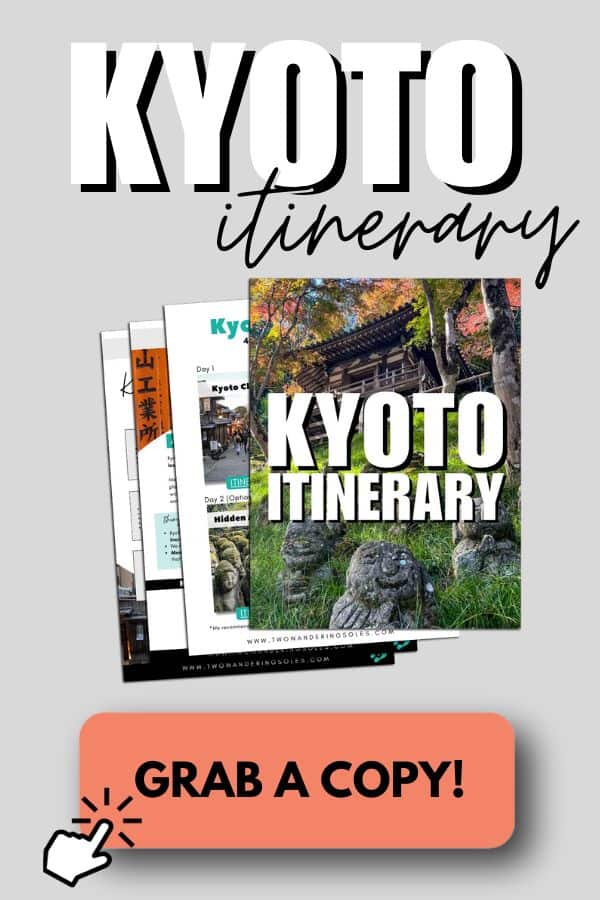This 2 day Kyoto itinerary is the perfect guide for your first visit to one of Japan’s most popular cities. From Fushimi Inari Shrine to the best restaurants, this Kyoto itinerary includes top sights, hidden gems, and insider tips from our own experience.
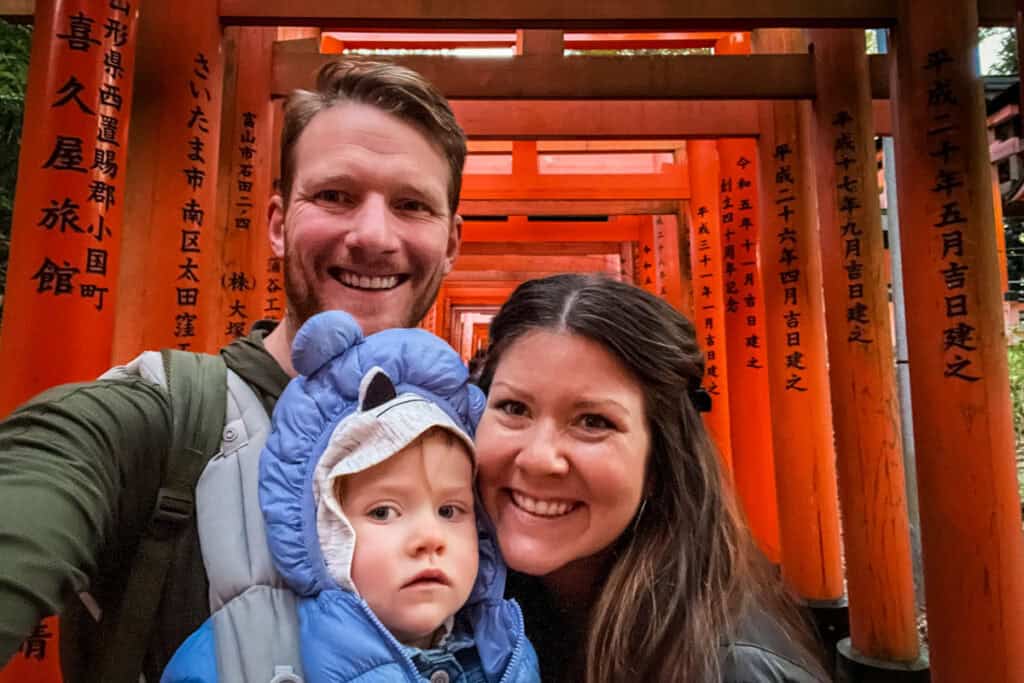
Kyoto has earned the nickname “the Cultural Capital of Japan”, and for good reason. The city is brimming with important historical sites, iconic landmarks, and world-renowned dining.
Known for its traditional architecture and well-preserved historic districts, Kyoto is a completely different experience compared to Tokyo or Osaka. While all deserve a spot in your itinerary, people often name Kyoto as their favorite city in Japan.
Being hugely popular with both international and local tourists, it should come as no surprise that Kyoto gets very crowded. The top sights typically become packed with visitors early in the day, and the crowds don’t let up until later at night.
We’ve been to Kyoto twice (Japan 3 times) and have used our first-hand experience to map the best route for you to see the top sights while avoiding peak crowds as much as possible.
In this action-packed itinerary, you’ll get an outline of exactly how to spend 2 days in Kyoto in order to maximize your time and experience the best of this idyllic Japanese city.
Plus, we’re also sharing the best places to eat (and which ones require reservations), where to stay, how to get around, and lots of other tips for a smooth trip.
And if you like what you see, be sure to check out our 2-week Classic Japan itinerary because we have quite literally done all the planning for you!
Kyoto Itinerary Contents
- How many days in Kyoto; Is 2 enough?
- 2 days in Kyoto itinerary
- Kyoto itinerary map
- Extra time in Kyoto
- Best time to visit Kyoto
- How to get around Kyoto
- Where to stay in Kyoto
- Budget for 2 days in Kyoto
- What to pack for visiting Kyoto
- More Japan travel resources
How many days in Kyoto is enough?
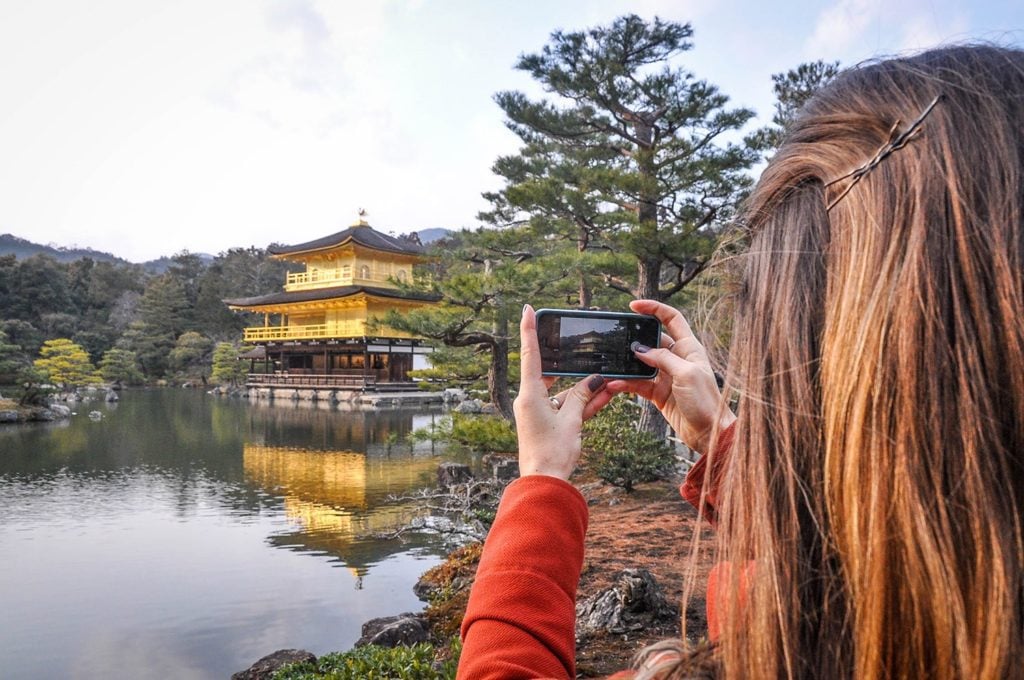
I’ll be straight with you: 2 days in Kyoto is not enough to see everything. In fact, you could spend a whole week here and barely scratch the surface.
Check out these stats and you’ll see why:
- Kyoto is home to more than 400 shrines and 1,600 temples
- There are 17 UNESCO World Heritage Sites in Kyoto
- Our list of things to do in Kyoto currently has 50 recommendations (and it grows every time we visit!)
It’s also worth noting that a lot of the city’s top sights are pretty spread out, so transportation will inevitably take up some of your time.
That said, we know a lot of people don’t have that much time to spend in Kyoto, especially if you’re splitting up your time in Japan between multiple cities.
If you follow this itinerary, then you’ll be able to see a lot of Kyoto’s most famous landmarks in just 2 days. We’ve chosen the very best sights and experiences and strategically planned this route in order to make the most of your time.
Day 1 in Kyoto
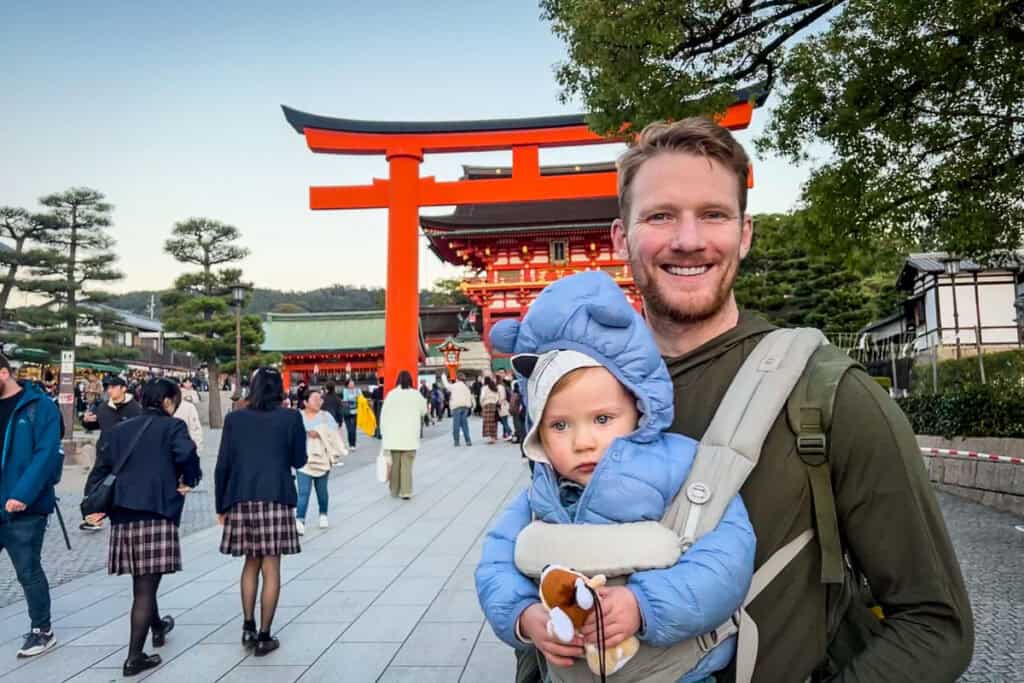
Welcome to Kyoto!
We hope you’re eager to start exploring, because today’s wakeup call is an early one (we’re recommending 5 a.m.). But trust me, it’ll be worth it!
Here’s an overview of today’s schedule:
Morning:
- Walk through the orange torii gates at Fushimi Inari Shrine
- Have lunch at Nishiki Market
Afternoon/Evening:
- Shop for unique souvenirs at Ninenzaka
- Get a view of the city from Kiyomizu-dera Temple
- Watch the sunset from a rooftop bar
- Explore Gion and grab dinner
- See Yasaka Shrine lit up at night
Fushimi Inari Shrine
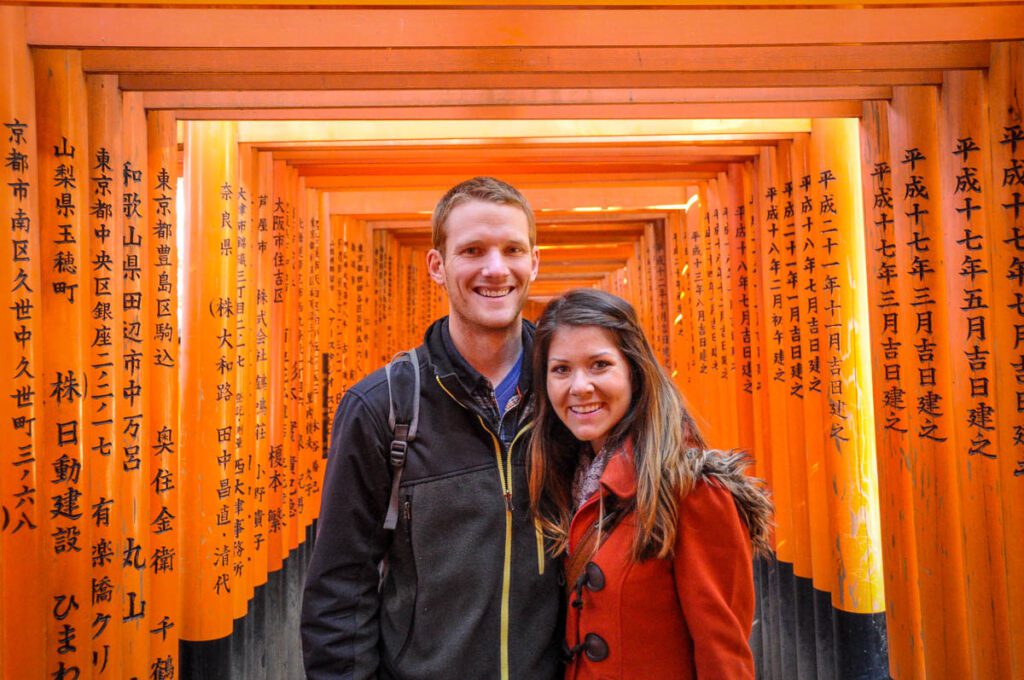
- Cost: Free
- Hours: Open 24/7
- Google Maps Location
Featuring more than 10,000 vermilion torii gates, Fushimi Inari Shrine is one of Japan’s most iconic landmarks.
Sometimes popular tourist attractions can be overhyped, but this is not one of those times.
We’ve been to Fushimi Inari twice and we’ll keep including it in our future plans because it never gets old. Following the path as sunlight streams through the orange-painted gates is truly a magical experience that we can’t quite describe.
We recommend you start your day early (trains begin running shortly after 5 a.m.), as this popular site gets very crowded very fast. Allot 2-3 hours at Fushimi Inari for hiking, photos, and rest stops (especially the stop at Yotsutsuji Intersection for a view over Kyoto!).
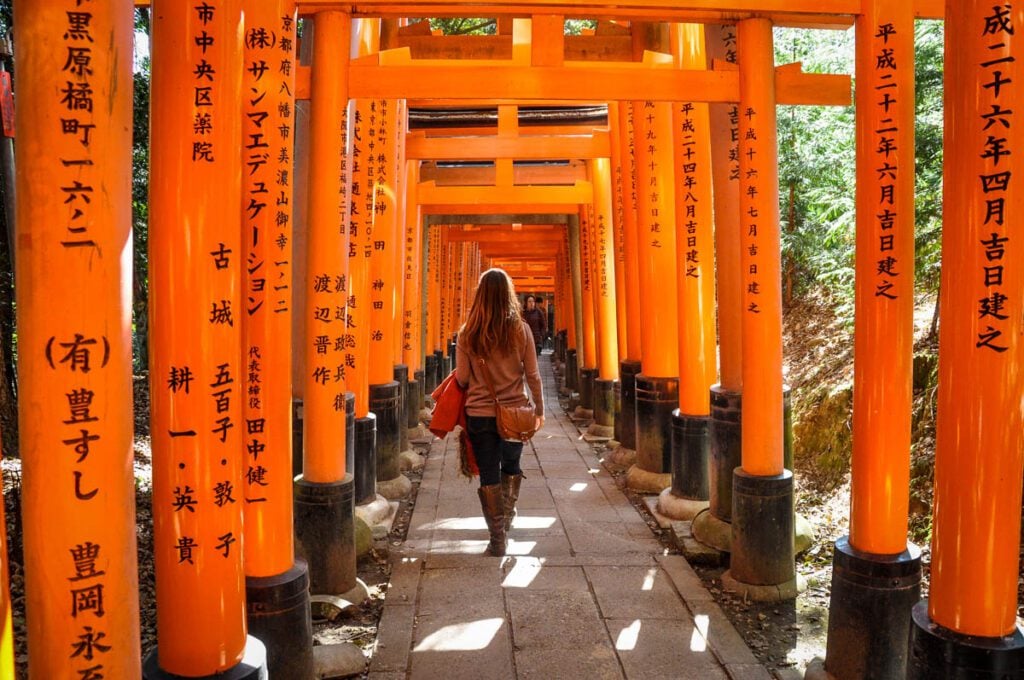
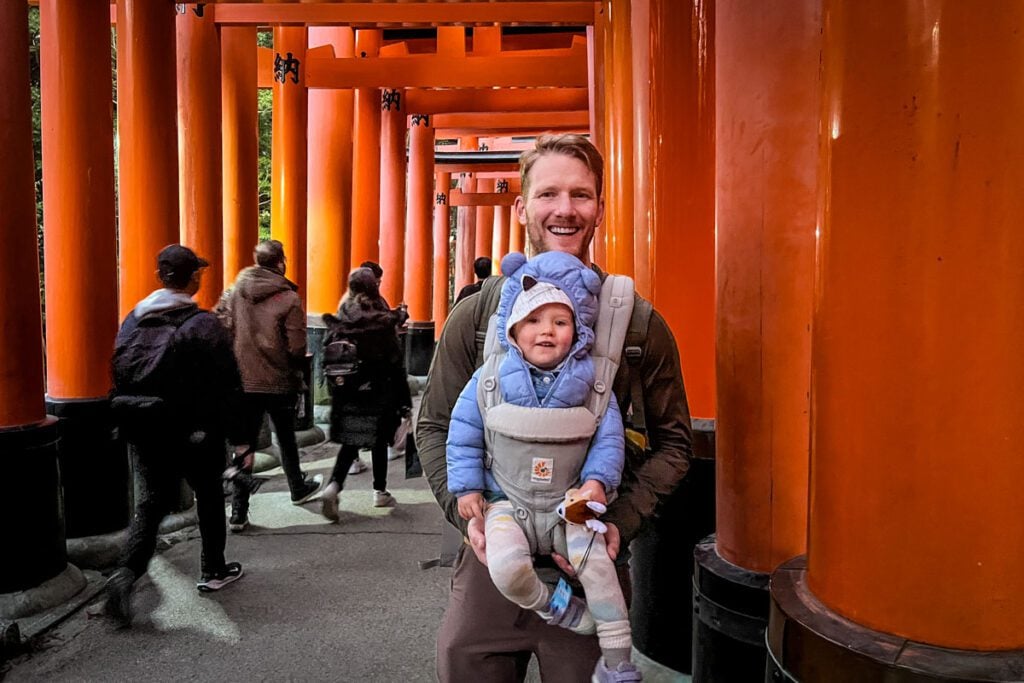
How to get there: Take the JR Nara Line from Kyoto Station. Ride the train for 5 minutes before getting off at JR Inari Station (the second stop). Once you exit the station, you will cross the street and you can’t miss the entrance to Fushimi Inari.
Alternatively, you can take the Keihan Main Line train to the Fushimi Inari Station. From here it is a short walk to the entrance.
We have an info-packed guide to Fushimi Inari that includes tons of tips, a map, fun facts, and a list of things to do here if you have more time.
Nishiki Market
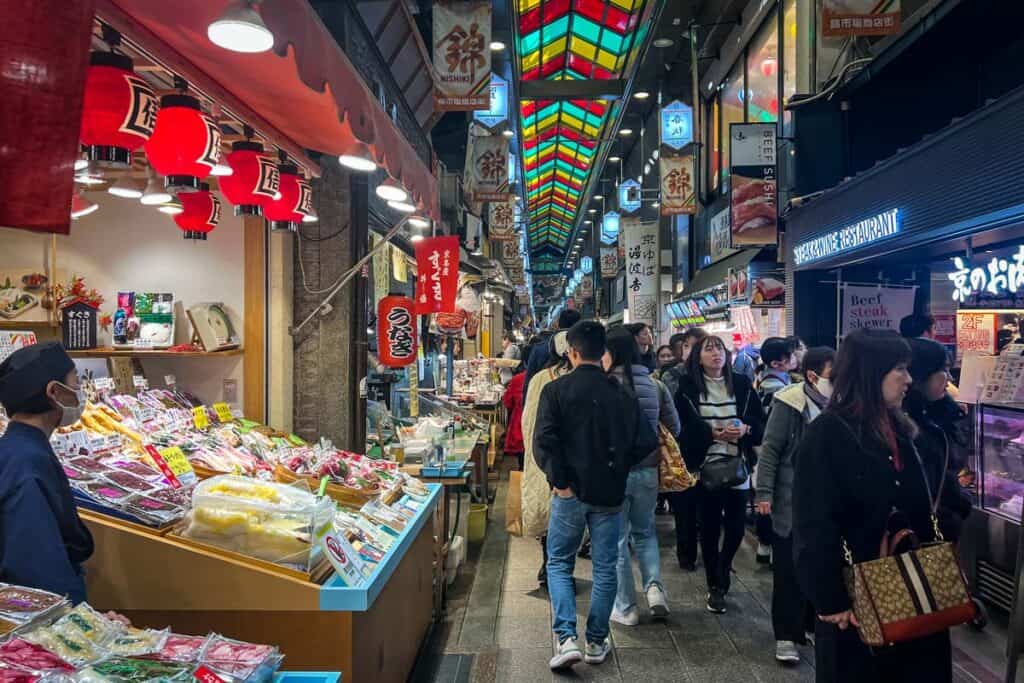
- Cost: Free to enter
- Hours: varies between vendors; most are open around 9 a.m. to 5 p.m.
- Google Maps Location
At this famous 400-year-old covered market, you’ll find a variety of shops selling fresh produce, pickled vegetables, spices, seafood, and more. There are also plenty of food vendors, making it a good spot to have lunch.
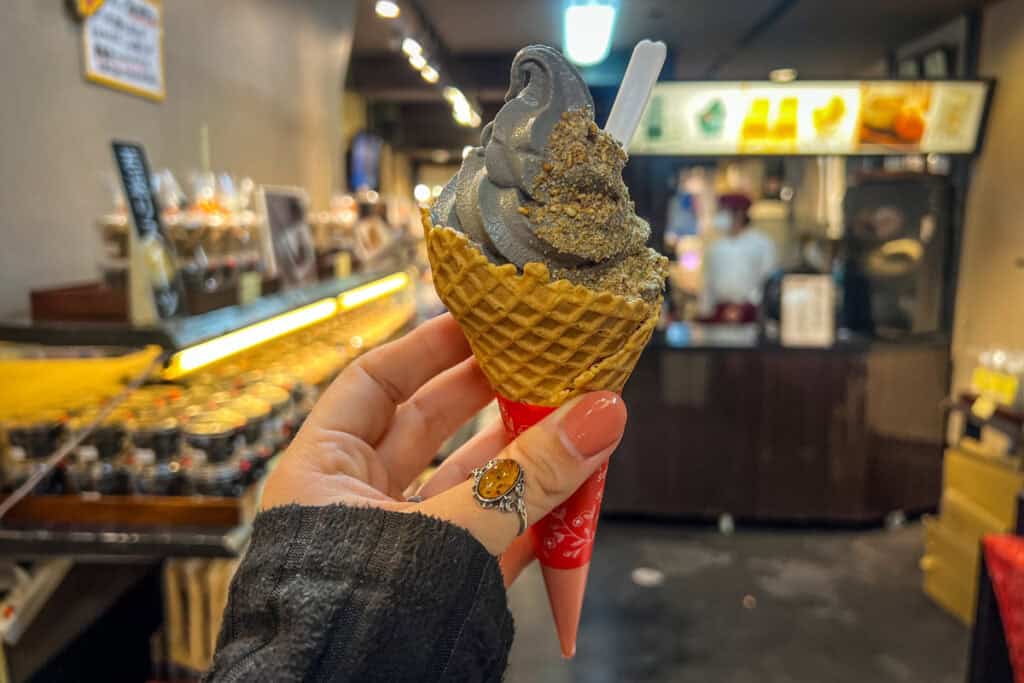
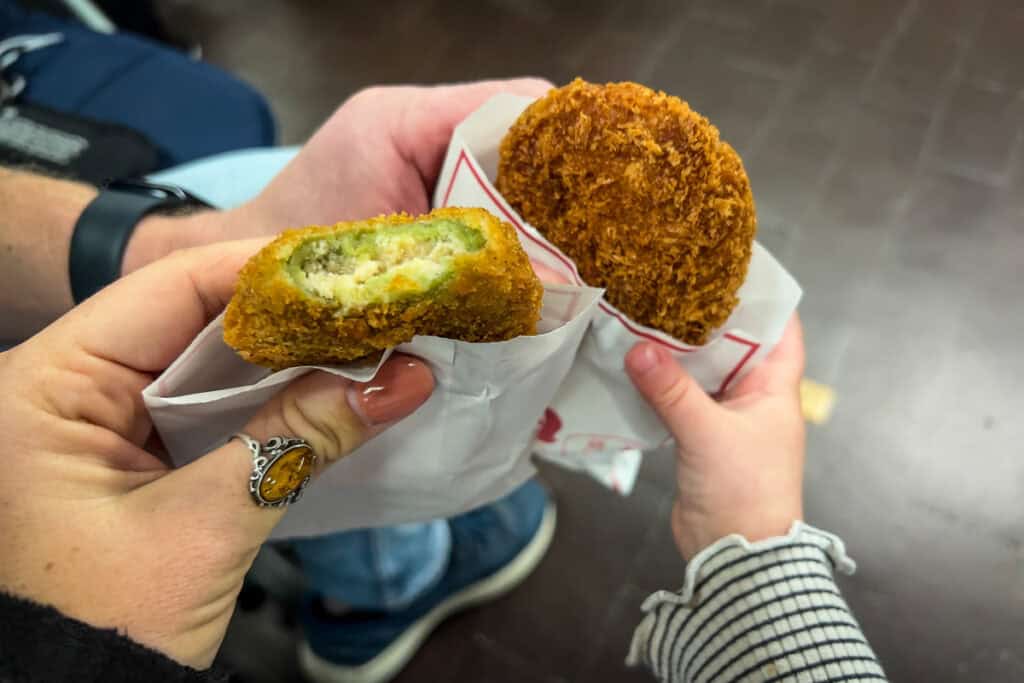
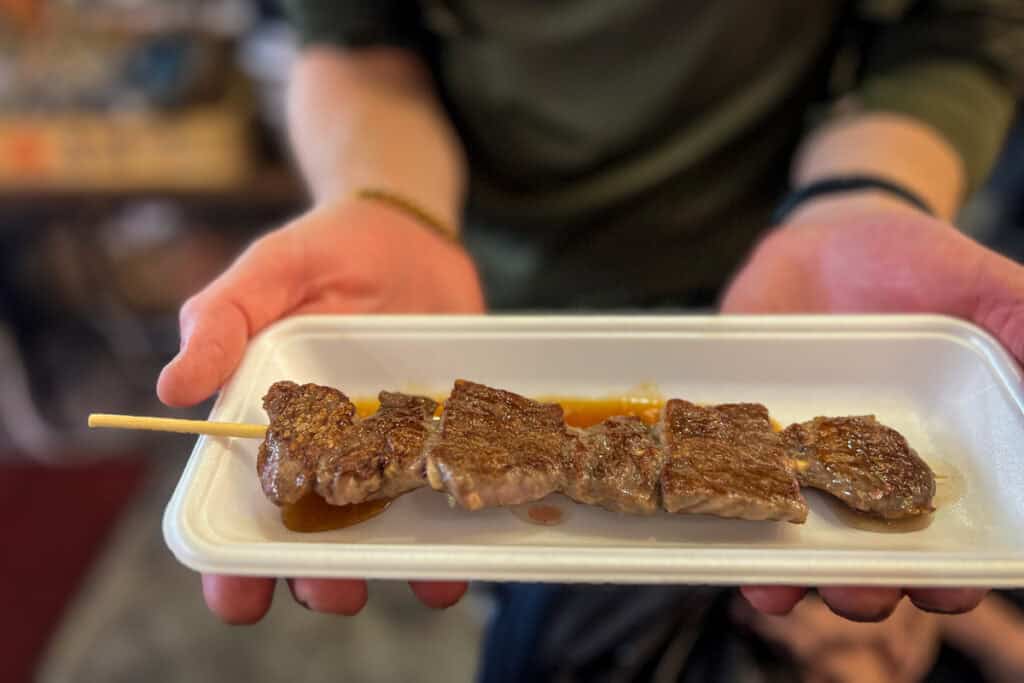
We recommend sampling a bunch of items for a “DIY Food Tour”. Get whatever looks good to you, or follow the list below for some of the items this market is particularly famous for:
- Tako-tamago: baby octopus that has been marinated and stuffed with a quail egg (famous at this market)
- Senbei: rice crackers
- Beef skewers
- Savory croquettes: filled with beef, chicken, corn, and other ingredients (there are several shops selling these, but one is Hiro Beef Kyoto)
- Tamagoyaki: Japanese omelet
- Seafood
- Konna Monja: small shop known for soy milk donuts (brown sugar, chocolate, & caramel flavors)
- koé donuts: Instagrammable donuts with unique flavors
- Black sesame ice cream (or other flavors)
Good to know: The market is extensive. If you feel like you’re only seeing produce vendors, keep walking. All the ready-to-eat food vendors are more or less in the same section of the market.
Ninenzaka shopping street
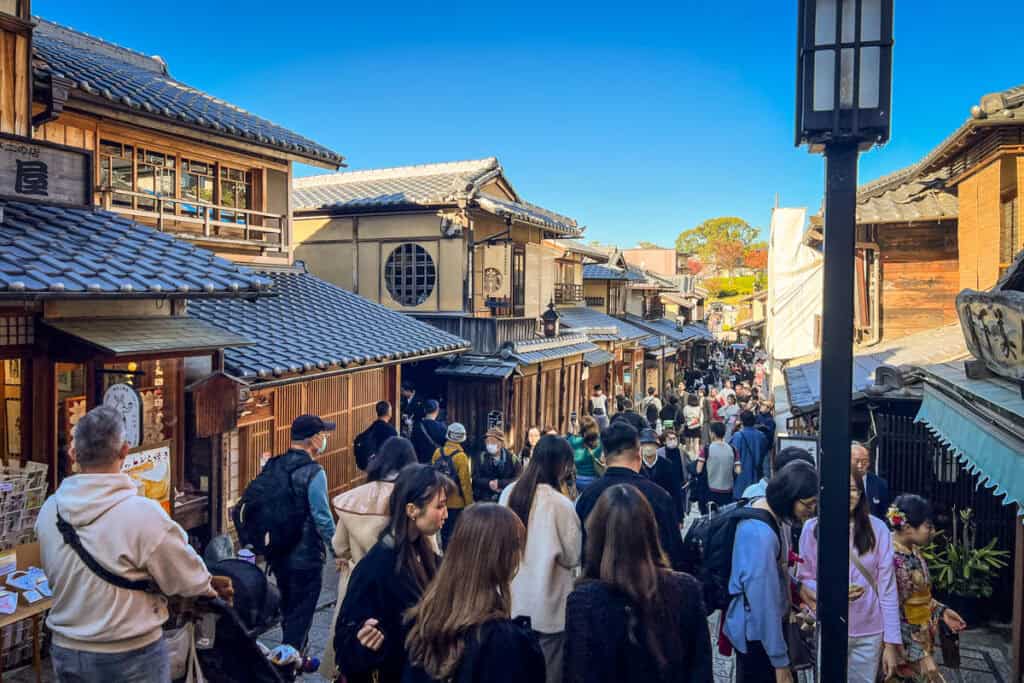
- Cost: Free to enter
- Hours: Most shops open around 10 a.m. and close around 5-6 p.m.
- Google Maps Location
Located in Kyoto’s Higashiyama Historic District, this pedestrian-only street is a picturesque example of “Old Kyoto”.
The mile-long street is packed with interesting shops, making it the perfect place to grab yourself a unique Japanese souvenir.
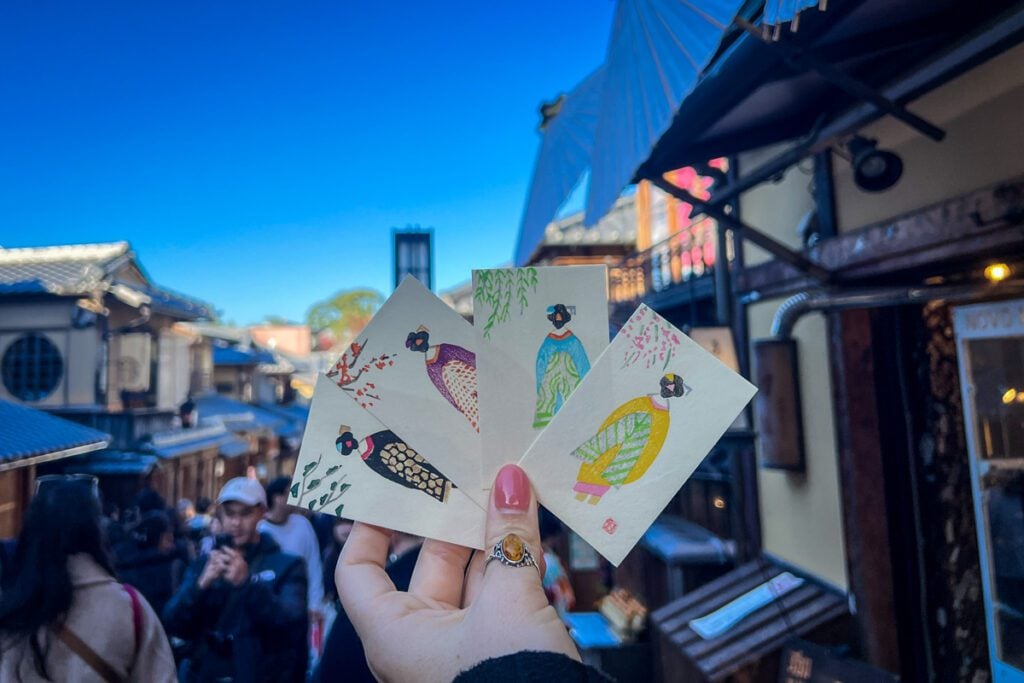
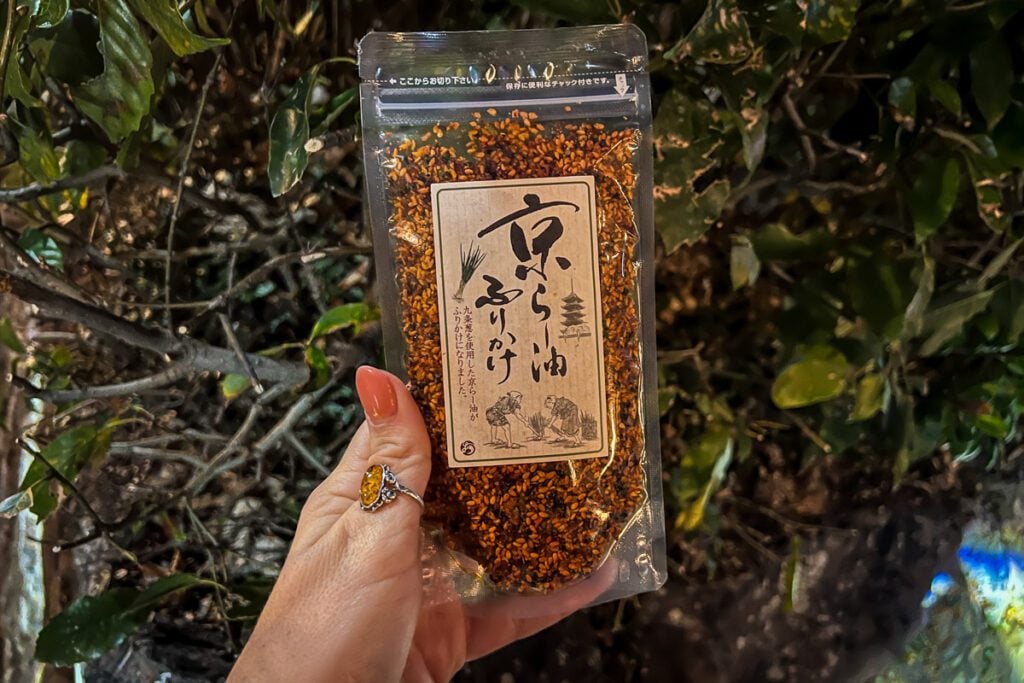
Brace yourself for crowds, because this area will be buzzing by midday. The good news, though, is that most of the shops and restaurants should be open. Here are a few of our favorite spots to check out:
- Glänta: At this popular ring shop, you can have a custom ring made in front of your eyes. Otherwise, you can take a workshop where you make your own ring for a memorable experience and a one-of-a-kind souvenir.
- 10 a.m. – 6 p.m.
- Reservations are required to make your own ring
- Ninenzaka Cafe Garakuta: This little coffee shop is recognizable by its 3 white umbrellas. In the entryway, a sweet older man sells his hand-stamped artwork, starting at only ¥100 for the simple designs. We purchased 4 pieces that each feature a maiko in different seasons for a fun souvenir.
- 11 a.m. – 6 p.m.
- Ocha-no-ko SAISAI: This spice shop offers samples of their signature spice blend. Pick up a packet (or 5!) for a souvenir that is both unique and delicious!
- 10 a.m. – 6 p.m.
Kiyomizu-dera Temple
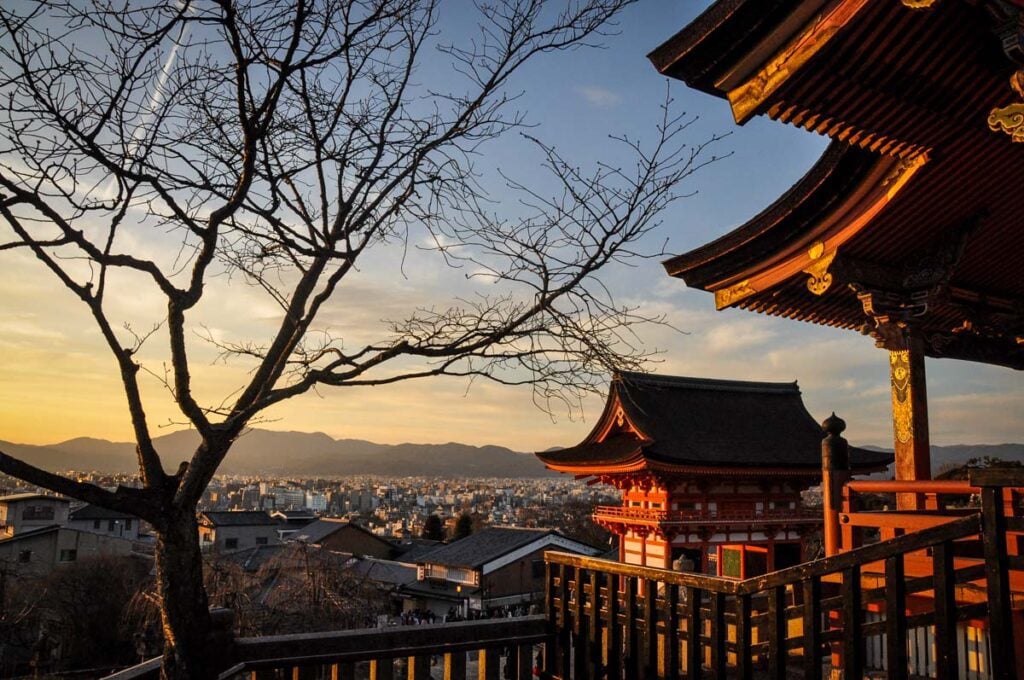
- Cost: ¥400
- Hours: 6 a.m. – 6 p.m. (occasionally open at night for illuminations)
- Google Maps Location
This mountaintop temple is a UNESCO World Heritage Site, one of the oldest Buddhist temples in Japan, and one of the most visited attractions in Kyoto.
The temple’s main draw is the wooden balcony that juts out over the city’s eastern hills where you can gaze out on Kyoto’s skyline and an endless sea of cherry and maple trees.
The view is especially spectacular during spring or autumn, when the cherry blossoms bloom and the fall foliage is aflame. But bear in mind that these are also the busiest times of year to visit.
One spot in this complex that many visitors miss is Otowanotaki Falls. Here, you’ll find three spouts with water streaming from them. It is said that if you drink from one of the streams of water, you will receive the corresponding blessing:
Left: success | Middle: love | Right: longevity
If you have time and want to wait in line, choose only one stream to drink from, because drinking from all three is considered greedy. Drink by using the cup on a stick to pour the water in your hand, then bringing it to your mouth.
Rooftop drinks for sunset
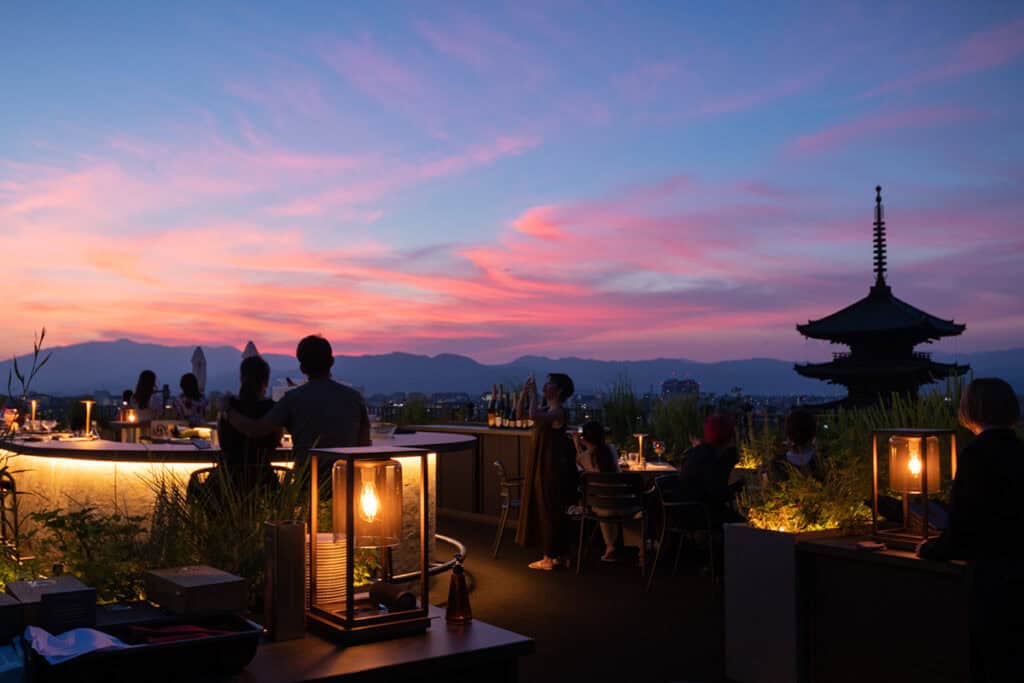
This just might be our favorite way to wind down after our first day exploring a new city.
Read the descriptions below and check locations to choose which rooftop bar in Kyoto is most your style and most convenient for you. Arrive before sunset in case you have to wait, and so you can enjoy Golden Hour just before the sun actually sets.
K36 Bar & Rooftop
best views, most expensive
- lovely views of Yasaka Pagoda
- cocktails & global menu
- cover charge & service fee
- reservations available (for tables with a minimum fee), as well as first come, first served tables (with no minimum)
- Google Maps location (Hotel Seiryu)
Cicon Rooftop Bar
hidden gem feel, beautiful design
- beautifully-designed rooftop oasis featuring twinkle lights, bonfire, and a cool atmosphere
- tacos & tapas
- wine & cocktails
- no cover charge
- reservations and walk-ins accepted
- Google Maps location (Nohga Hotel)
in the Moon
fun & lively atmosphere
- nice views overlooking the city & river
- western cuisine & snacks
- no reservations
- lively atmosphere & music
- decent selection of cocktails (mojitos are recommended)
- Google Maps location
Gion
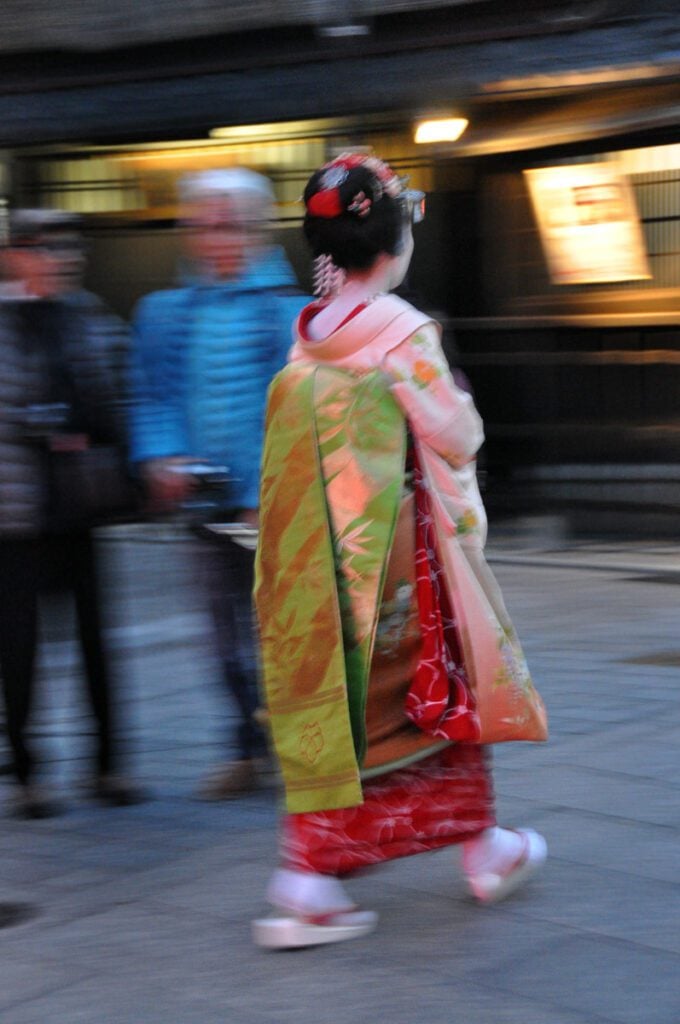
Gion is known for its temples, shrines, and historical architecture, as well as upscale Japanese restaurants, ochaya (teahouses), and boutiques. Famously known as the “Geisha District”, Gion is also one of the best places in the city to spot the elusive entertainers.
Did you know? While most foreigners use “geisha” as a catch-all for the elaborately-adorned Japanese performance artists, geisha is actually a regional term used in Tokyo. In Kyoto, the proper term is geiko.
Here are some noteworthy spots to check out in Gion:
- Izutsu Yatsuhashi Honpo: shop known for a regional sweet called yatsuhashi. This triangular treat comes baked & unbaked (try both) and is made with glutinous rice flour, sugar, and cinnamon.
- Hanamikoji Street: historic street with lots of shops
- Yasui-Konpiragu: shrine known for a large rock with a hole you can pass through and make a wish
- Kodaiji Temple: during specific dates in autumn, spring, and summer, this temple is illuminated at night (¥600 entry until 9:30 p.m., no reservations needed); check schedule here for the laser show and illuminated bamboo grove
Want a local guide? Check out this local’s walk of Gion by night.
Important note: There are new rules banning tourists from entering some alleyways and from taking photos in others. Look for signs and respect them. There are fines if you break these rules.
Dinner

No doubt by now your tummy is grumbling, so make your way to one of these top-rated restaurants in the Gion district. Be sure to note which ones require reservations.
- Teppan Tavern Tenamonya: Izakaya that gets rave reviews, must be booked well in advance
- Gion Tanto: okonomiyaki spot with vegan options
- Izustu: very small menu, known for unagi don (eel rice bowl), views of the river
- Wagyuyakiniku Toku: sleek restaurant for waygu, reservations recommended
- Tempura Endo: high end tempura restaurant, multiple courses, reservations recommended
- Teppanyaki Manryu: small family-run teppanyaki restaurant, reservations recommended
Illuminations at Yasaka Shrine
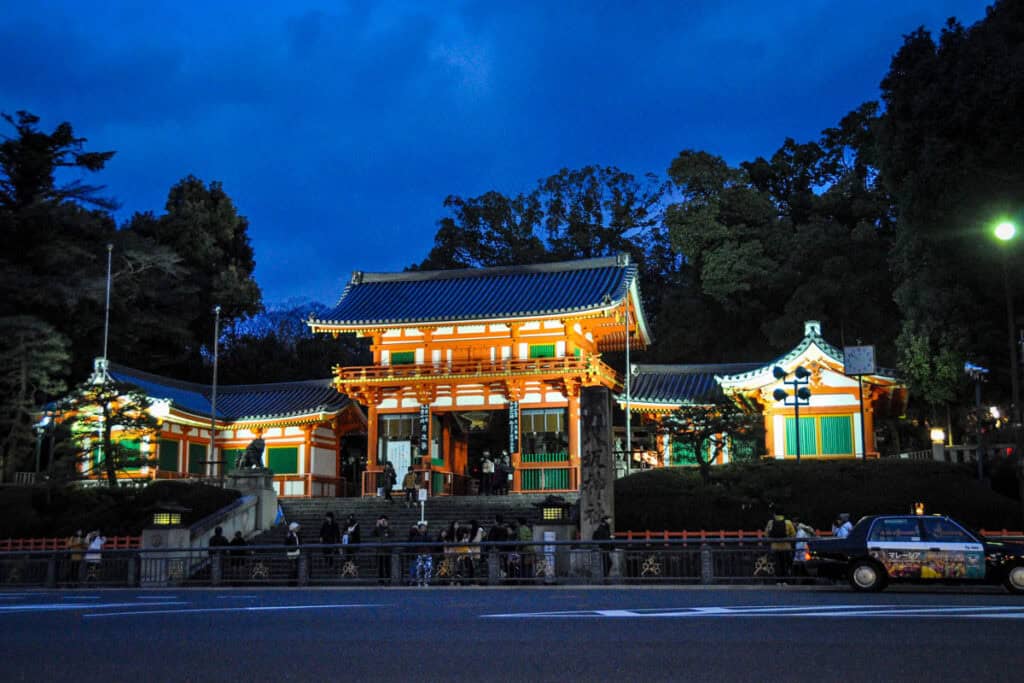
- Cost: Free
- Hours: open 24/7
- Google Maps Location
This Shinto shrine with its bright vermilion buildings and rows of paper lanterns is especially beautiful when illuminated after dark. Extend your walk by strolling through the adjacent Maruyama Park.
Good to know: The festival of Yasaka Shrine, Gion Matsuri, takes place here every July. It is one of Japan’s most famous festivals and draws millions of visitors each year. Keep this in mind as you plan your trip if you want to avoid the crowds (or if you want to check out the festival for yourself!).
Day 2 in Kyoto
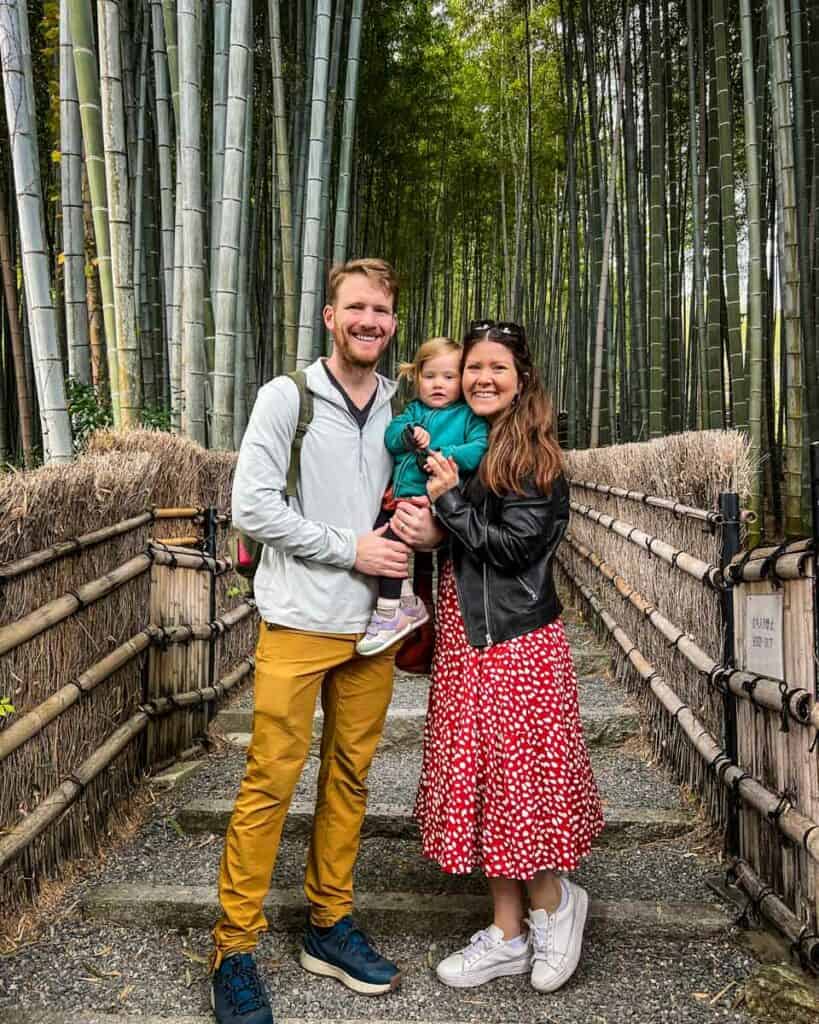
On day 2 of this 2 day Kyoto itinerary, you’ll have the chance to explore hidden gems still somewhat off the radar of most tourists. Plus, we’ll recommend a variety of activities so you can choose the ones that best suit your travel style.
Here’s an overview of today’s schedule:
Morning:
- Visit Otagi Nenbutsuji Temple
- Head to Adashino Nenbutsuji Temple (and a hidden bamboo grove!)
- Take in the view from the Arashiyama Park Observation Deck
- Have lunch by the river
Afternoon/Evening:
- Choose your own adventure:
- Slow down and enjoy Arashiyama
- Photograph the Golden Pavilion (Kinkaku-ji)
- Take part in a tea ceremony
- Travel to Nara
- Have dinner in Kyoto
- Sip cocktails at a speakeasy (or other nighttime adventures)
Arashiyama
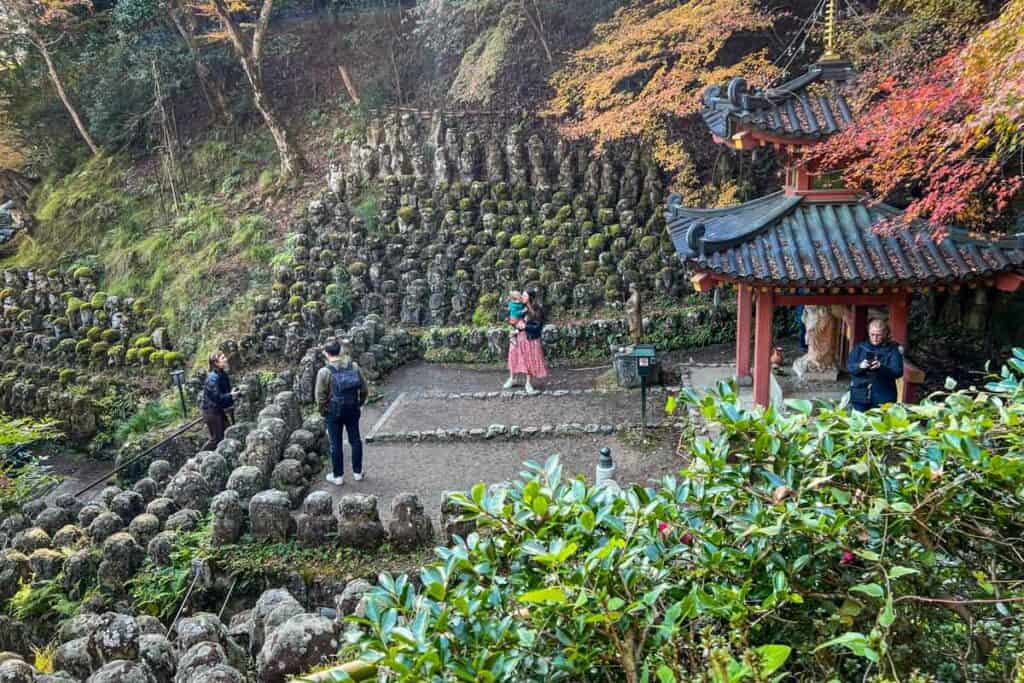
Located on the western outskirts of the city, Arashiyama is the second most popular sightseeing district in Kyoto.
It’s most famous for the Arashiyama Bamboo Grove, which is almost always listed as a must-do in Kyoto. And we can see why – wandering through a forest of towering bamboo stalks that sway ever so slightly in the breeze creates an almost otherworldly atmosphere.
But if you’re picturing a peaceful stroll through a quiet forest where you can hear the bamboo whisper in the wind, then you’ll likely be disappointed. This place is absolutely packed with tourists at pretty much all hours of the day.
If you, like us, are not a fan of crowds, keep reading because we have a hot tip on where you can find a hidden bamboo grove many tourists don’t know about.
Otagi Nenbutsuji Temple
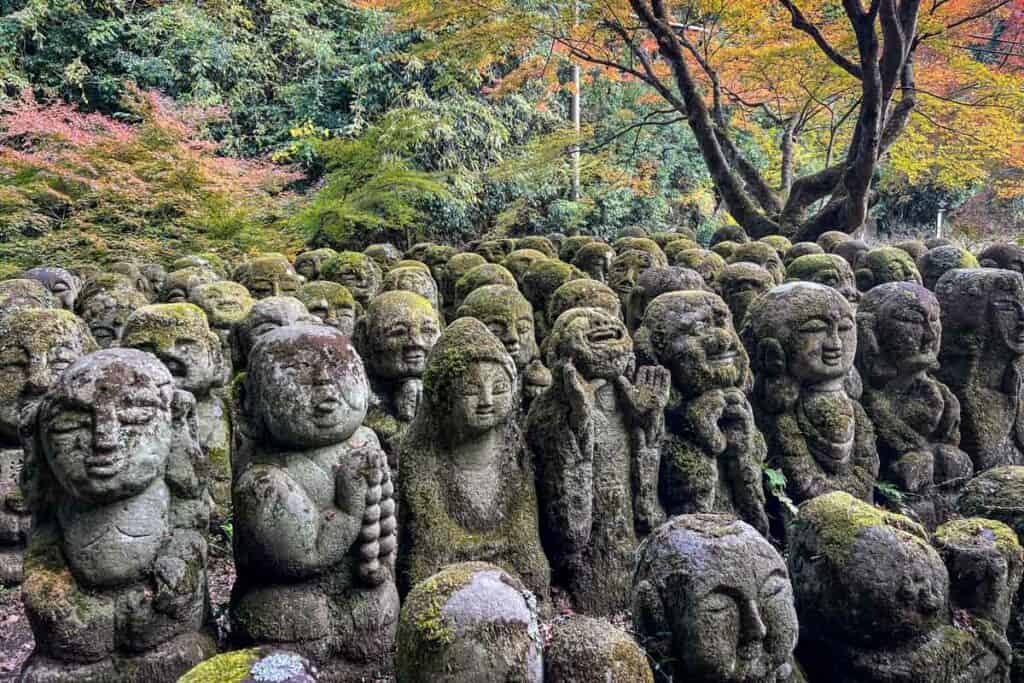
- Cost: ¥400
- Hours: 9 a.m. – 4:15 p.m.
- Google Maps Location
This is perhaps one of my favorite temples in Japan. While small, it is extremely beautiful and less crowded than many others in the Kyoto area.
But what makes it truly special are the 1,200+ stone statues, each with its own unique facial expression.
Adashino Nenbutsuji Temple & Bamboo Grove
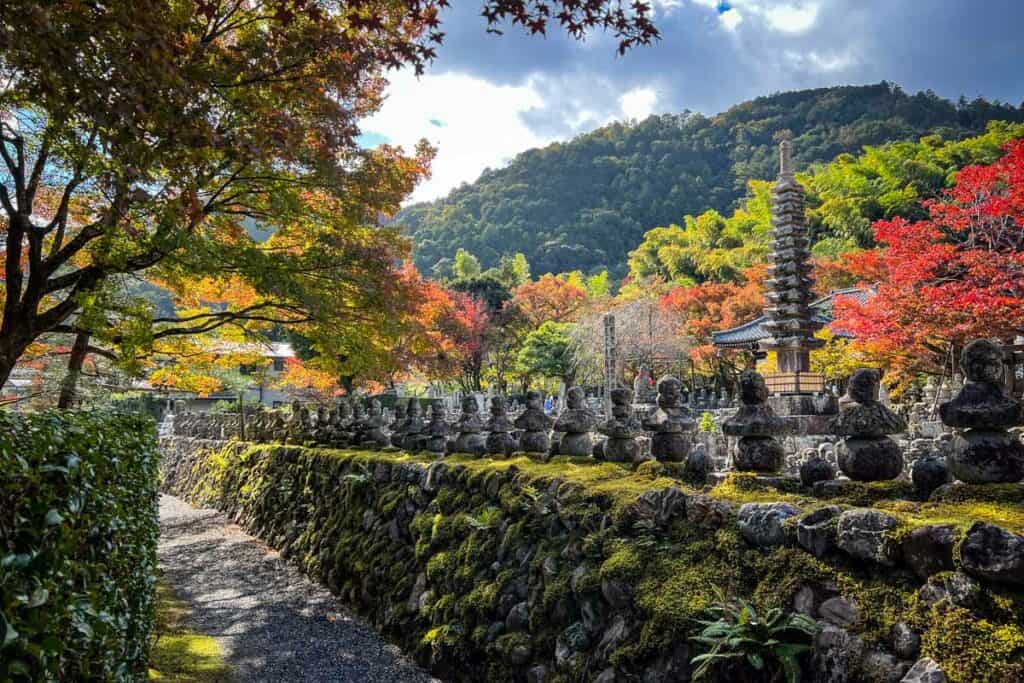
- Cost: ¥500
- Hours: 9 a.m. – 4:30 p.m. (3:30 p.m. December to January)
- Google Maps Location
This Buddhist temple is a tranquil place to have a wander. The main section has 8,000 statues dedicated to lonely souls who have passed on.
While the temple grounds themselves are nice to see, the main draw for most travelers is the hidden bamboo grove near the southwest side of the grounds.
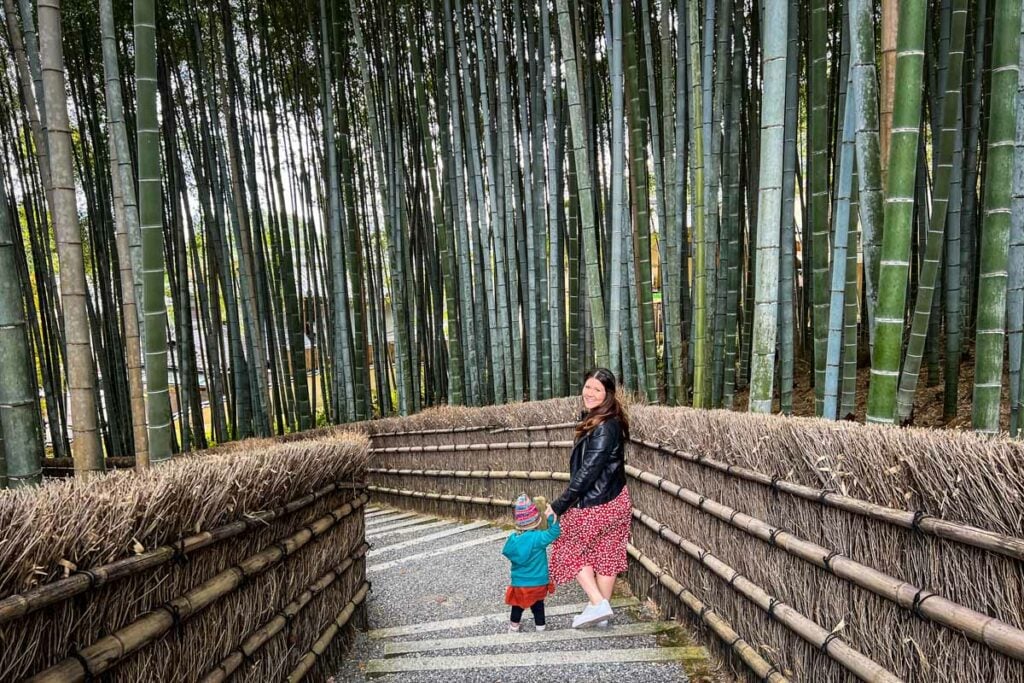
The bamboo grove at this temple is small and the path is short, but it is much, much less crowded than the more famous Arashiyama bamboo grove. This doesn’t mean there won’t be other savvy travelers here at the same time, but it’ll be much easier to get good photos here than at the alternative.
Our opinion: While the famous bamboo forest is stunning, we personally feel like the jostling crowds of tourists waving selfie sticks in the air kinda ruin the illusion of a tranquil oasis. We’re not fans of crowds, so our visit to the Adashino Nenbutsuji bamboo grove was much more enjoyable.
Take a look at these photos from the two bamboo groves and you’ll see what I mean:
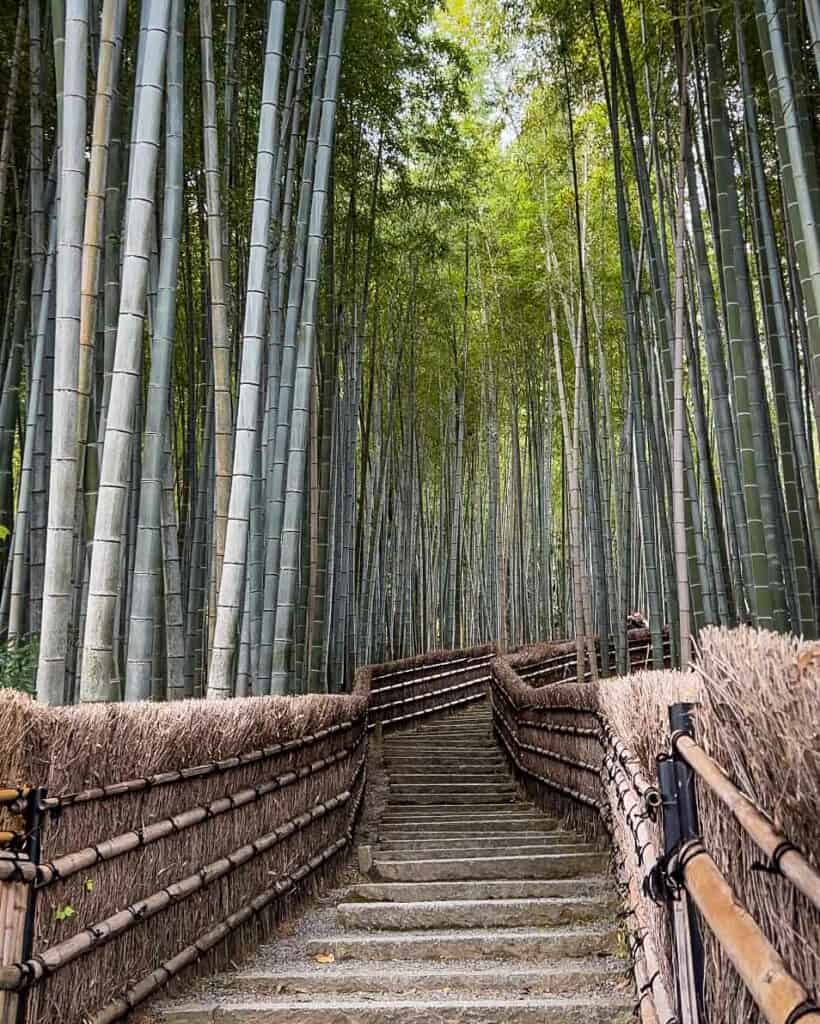
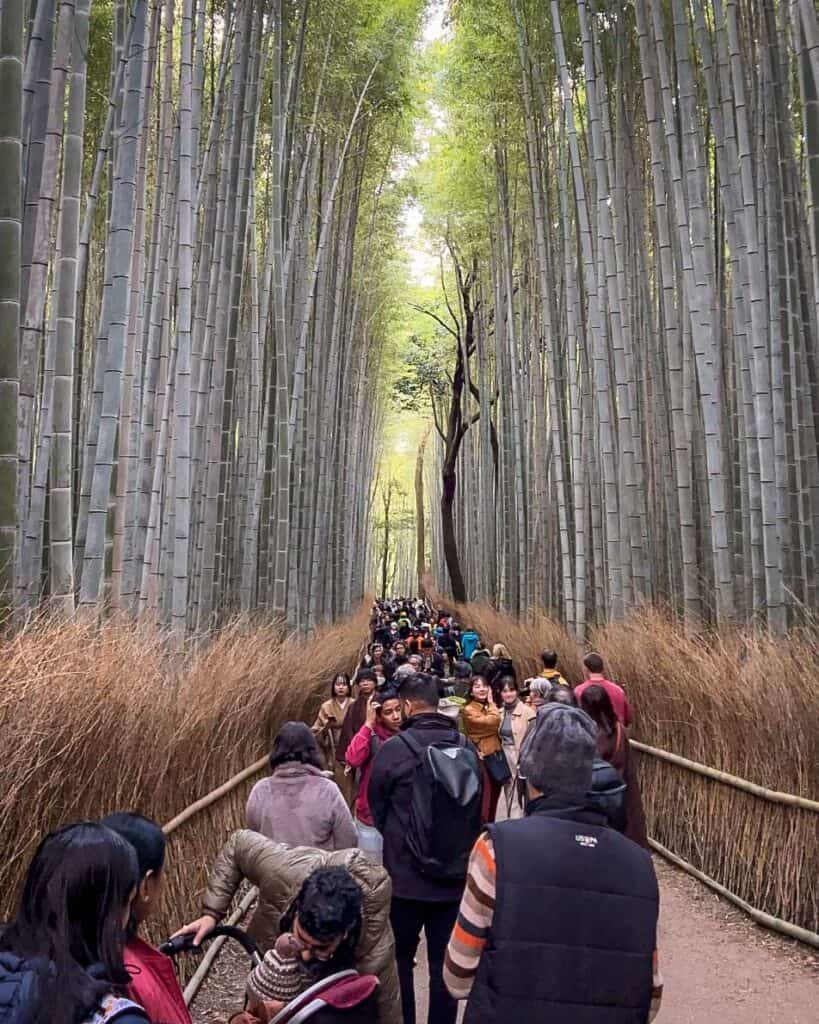
Arashiyama Park Observation Deck
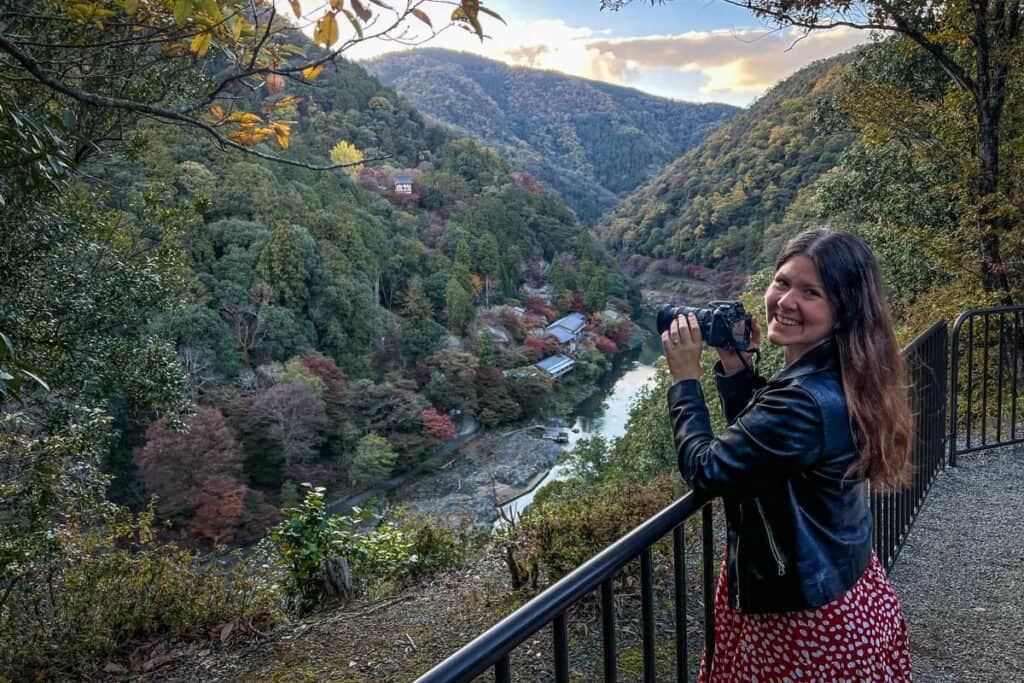
- Cost: Free
- Hours: open 24/7
- Google Maps Location
Next, you’ll head to Arashiyama Park. Enjoy the scenery as you walk slightly uphill until you reach this viewpoint overlooking the river (particularly stunning in autumn and spring). If you walk a little further, you’ll find a lesser-known viewpoint that has another lovely angle.
Psst! Arashiyama Park is just around the corner from the super-famous bamboo forest. Sneak a peek at it; when you see the shoulder-to-shoulder crowds, we think you’ll be happy you opted for a hidden bamboo grove instead!
Lunch
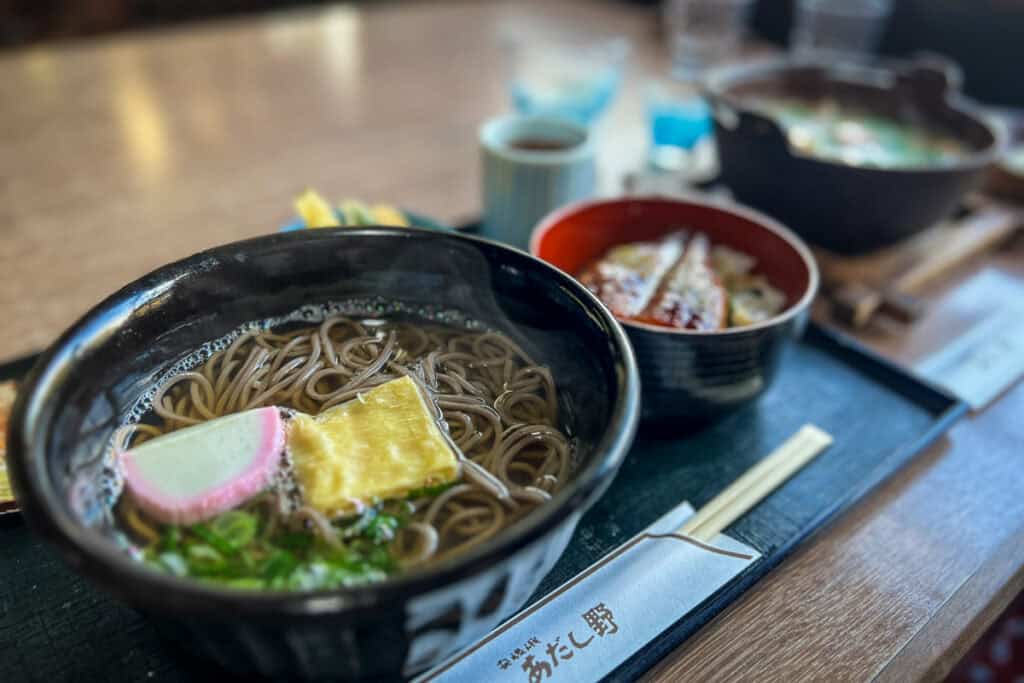
There are some incredible lunch options in Arashiyama that are more than just food, but memorable dining experiences.
These restaurants require reservations in advance:
- Arashiyama Itsukichaya
- seasonal set menus (starting at ¥4,000) that include tempura and traditional Japanese dishes
- beautiful seating overlooking the river
- popular with tourists
- Make reservations here (up to 1 month in advance; book early!)
- Shoraian
- refined kaiseki menu with a focus on tofu
- cozy spot on the river, feels like a hidden gem
- Not possible to make reservations online; email your hotel an politely ask if they can make reservations for you
- Tenryuji Temple Shigetsu
- vegan set menu (Buddhist cuisine)
- Can make reservations online or walk in & hope the wait isn’t long
- featured in 2023 Michelin guide
- Tip: if you choose this restaurant, switch your itinerary to visit Tenryuji Temple just before lunch
These restaurants don’t require reservations, but you may need to wait a bit if they’re busy:
- Kameyamaya
- local style set meals right next to the river
- try to get a seat on the second floor for nice views
- Arashiyama Yoshimura
- soba and tempura shop located on the river
- put in your name, then come back when your table is ready
- Ogura Chaya
- cozy udon shop with lovely outdoor seating area
- good choice if you’re on a budget
- hours change seasonally
Afternoon: Choose your own adventure!
- Slow down and enjoy Arashiyama
- Visit Kinkaku-ji Temple
- Participate in a traditional tea ceremony
- Travel to Nara to meet the bowing deer
Arashiyama
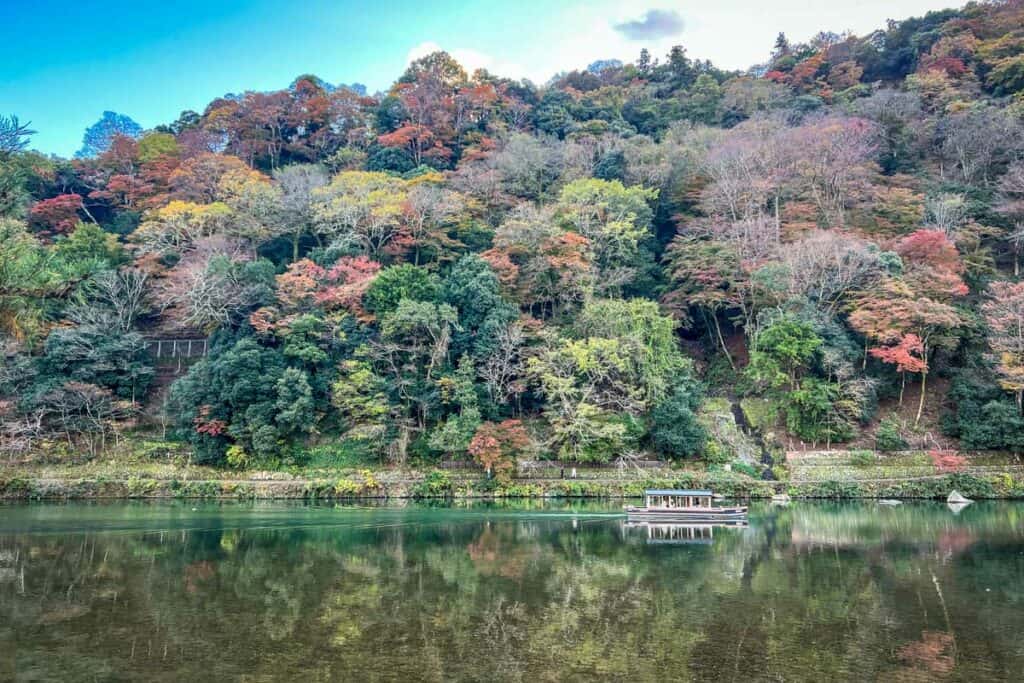
If you feel like this itinerary is moving too fast (we’ve packed in a lot for 2 days!) or you’re simply really enjoying your time in Arashiyama, why not stick around? There’s so much more to see!
- Hop on a traditional boat for a relaxing cruise on the Katsura River
- See Japanese macaques up close at the Iwatayama Monkey Park
- Walk through the Kimono Forest, an art exhibit featuring poles covered in colorful kimonos (beautiful at night and during the day)
- Feel a world away from the city at Jojakkoji, a peaceful forested temple
- Explore Tenryū-ji, a Zen temple with a teahouse and large gardens
- Cross Togetsu-kyo Bridge, a 400-year-old wooden footbridge
- Wander past historic houses on Saga Toriimoto Preserved Street, where few tourists venture
- Soothe your tired toes in a warm foot bath at the train station
Insider tip: If you’re visiting during sakura (spring) or momiji (fall) seasons, we highly recommend stopping at Okochi Sanso Garden as it is absolutely stunning (it was one of our favorite spots in all of Japan for fall foliage!). Outside of these seasons, the ¥1,000 entrance fee may not be worth it to all visitors, but it is a peaceful place in an otherwise very crowded area.
Kinkaku-ji Temple (Gold Pavilion)
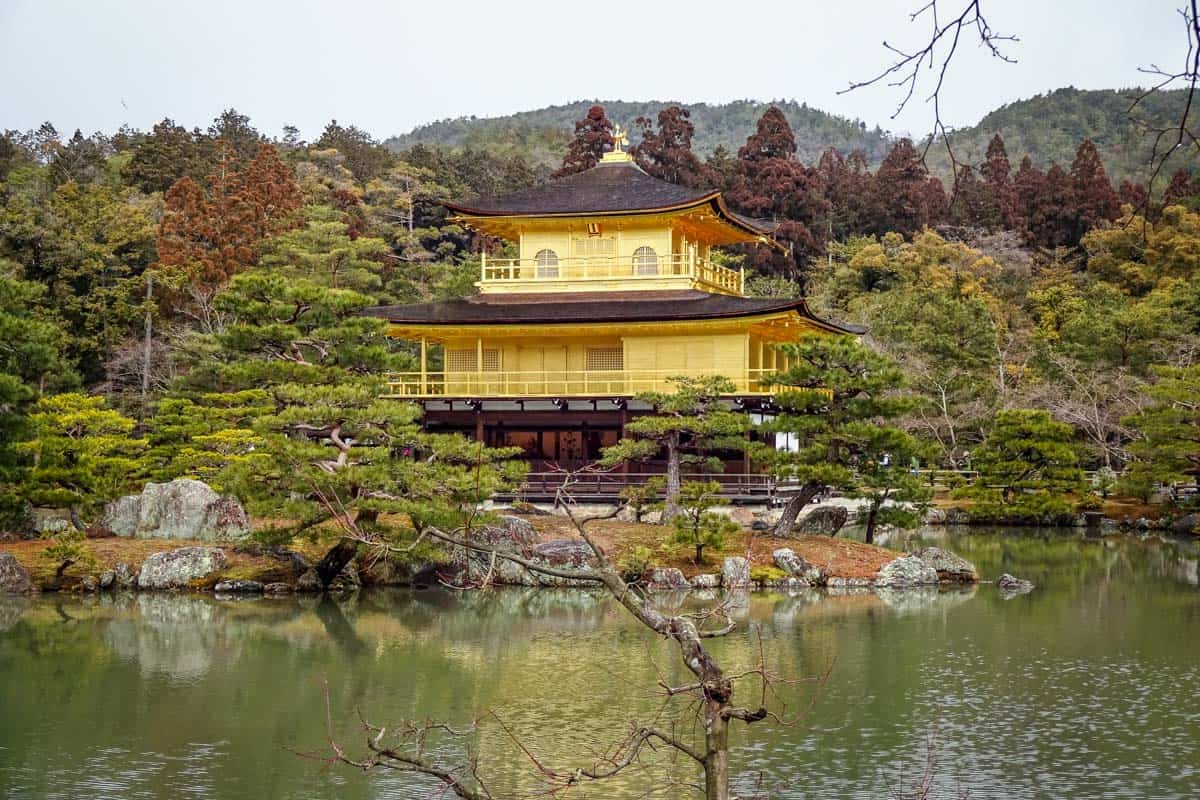
- Cost: ¥500
- Hours: 9 a.m. – 5 p.m.
- Google Maps Location
This 3-story Zen temple is known for its gold leaf facade and beautiful setting amidst lush gardens and a large reflecting pool. It is one of the top sights in Kyoto and definitely worth a visit, but be warned – the grounds are teeming with tour groups at practically all hours.
The morning is said to be the least busy, but dusk the most beautiful. Viewing the golden temple as the sun starts to set is spectacular.
To get to Kinkaku-ji from Arashiyama, you’ll need to take a train and a bus. The journey takes around an hour each way, so visiting this temple will take a decent chunk out of your day.
Our opinion: This might be an unpopular take, but if you only have 2 days in Kyoto, I would skip Kinkaku-ji. Though the temple is beautiful, it’s also very crowded, and I personally feel like the amount of time it takes to get there is not worth it for what is essentially a photo stop.
Tea Ceremony
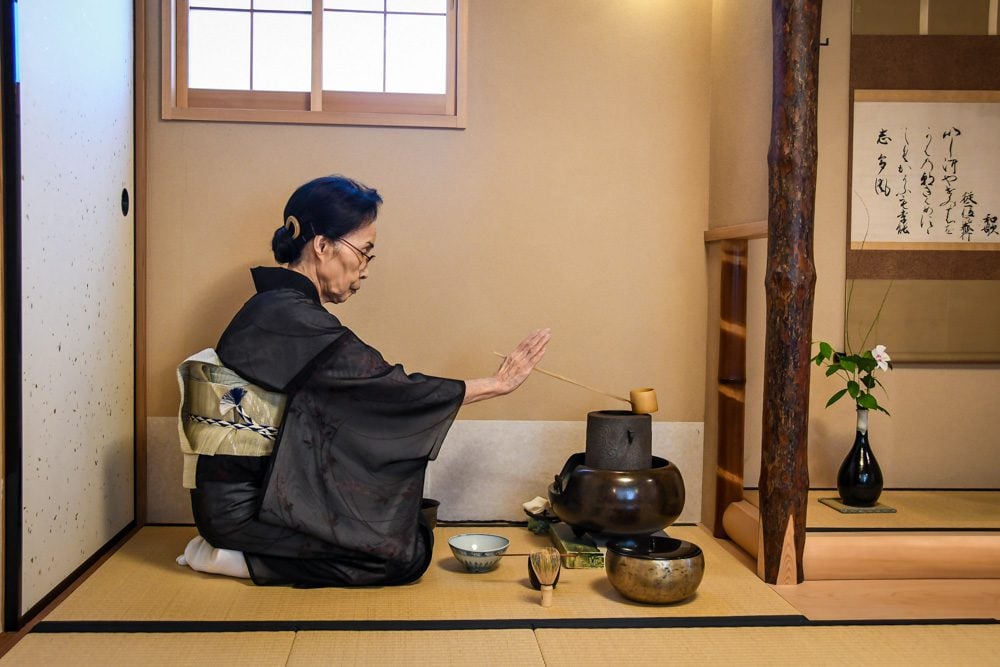
Taking part in a tea ceremony is a bucket list cultural experience in Japan. What better place to do it than the country’s cultural capital?
There are 2 fantastic tea ceremonies in Kyoto, both with rave reviews. Read the details to see which would be better suited for you.
Jotokuji Temple Tea Ceremony
- Only available on weekdays
- Less expensive (from $22 per person)
- Available times: 11 a.m., 12:30 p.m., 2 p.m., 3:30 p.m., 5 p.m.
- Duration: 70 minutes
- Children are allowed
- Read through the description to see if you think it’s a suitable experience for them
- Kimono can be rented for an additional cost
- Google Maps location
- Book this experience
Mai-ko Tea Ceremony
- Available everyday
- More expensive (from $46 per person)
- Available times: every hour from 10 a.m. – 6 p.m.
- Duration: 90 – 120 minutes
- Children under 7 are not allowed
- Kimono rental included
- Google Maps Location
- Book this experience
Nara
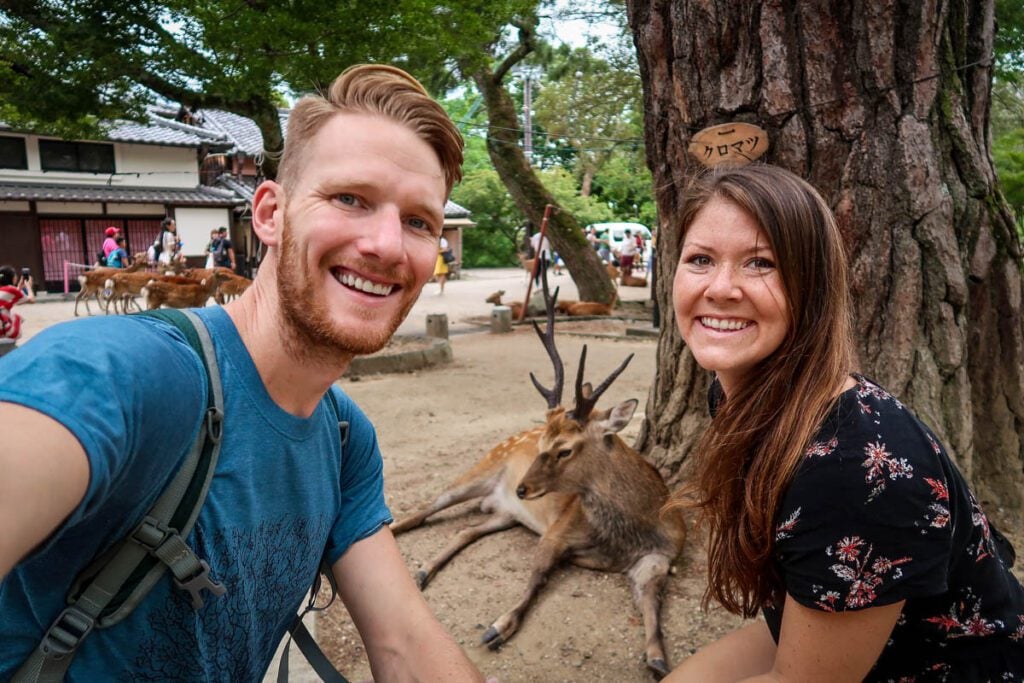
Being that it’s less than an hour away from Kyoto, you could easily squeeze in a visit to Nara and return to Kyoto for a late dinner.
Nara was Japan’s first permanent capital and is home to some of the largest and oldest temples in the country. It’s a fascinating city full of history and culture.
But the main draw for most visitors are the 1,400+ deer that roam freely throughout town, bowing to tourists in exchange for crackers. Yes, they really do bow!
Since you’ll only have a few hours in Nara, we’d strongly recommend sticking to the following sites. We’ve chosen this list specifically because these sites are all close together (all located in Nara Park) and they’ll give you a good taste of what Nara has to offer.
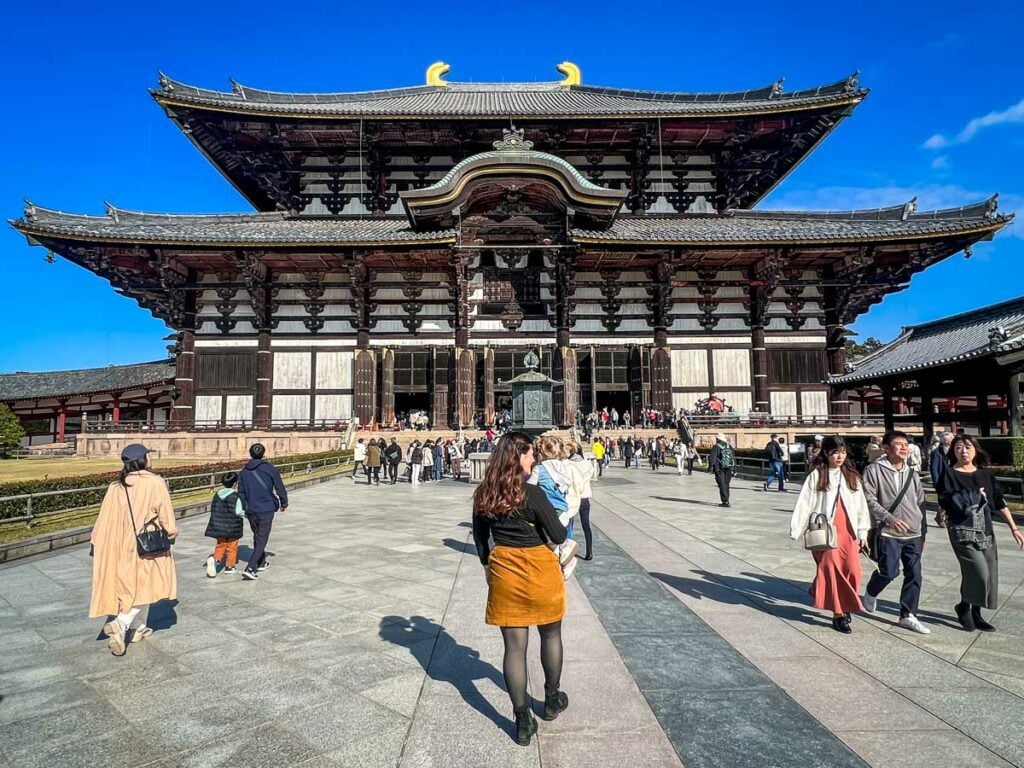
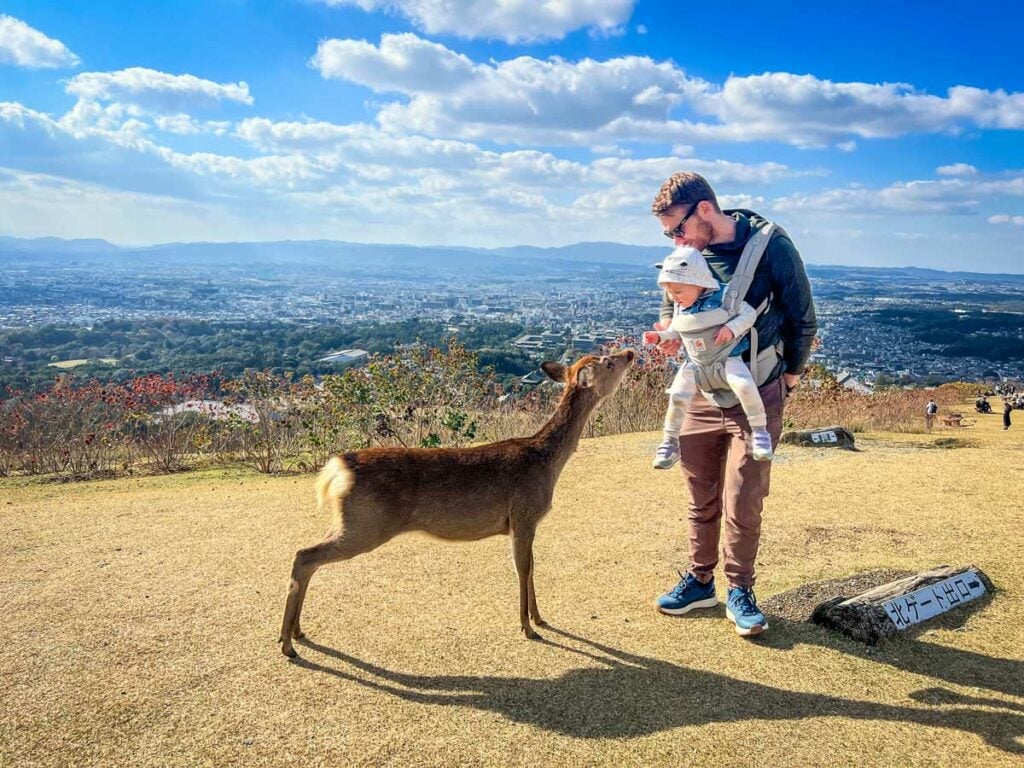
Here’s how we’d spend an afternoon in Nara:
- Wander the famous Tōdai-ji Temple
- See a giant bell at Todai-ji Shoro (Bell Tower)
- Step back in time on a historic street (Todai-ji Urasando)
- Get views of Nara at Todaiji Nigatsudo Temple (“February Hall”)
- Meet the famous deer in Nara Park
- If you decide to feed the deer, make sure you read this first!
- Hike Mount Wakakusa for the best view in the city (and a less-crowded place to see deer!)
There are a couple of ways to get to Nara from Kyoto by train:
- From Kyoto Station, take the Kintetsu Limited Express line Yamato-Saidaiji Station, then take the Kintetsu-Nara Line to Kintetsu-Nara Station.
- Time: 34 minutes
- Cost: ¥1,280
- From Kyoto Station, take the Nara Line to Nara Station.
- Time: 44 minutes
- Cost: ¥720
Driving yourself? From Kyoto to Nara, the fastest route is via a toll road. It is approximately 27 miles (43km) and should take roughly 50 minutes. All main routes between these cities have tolls.
If you can extend your itinerary another day, we’ve outlined the perfect Nara day trip from Kyoto that will let you see a lot more!
Dinner
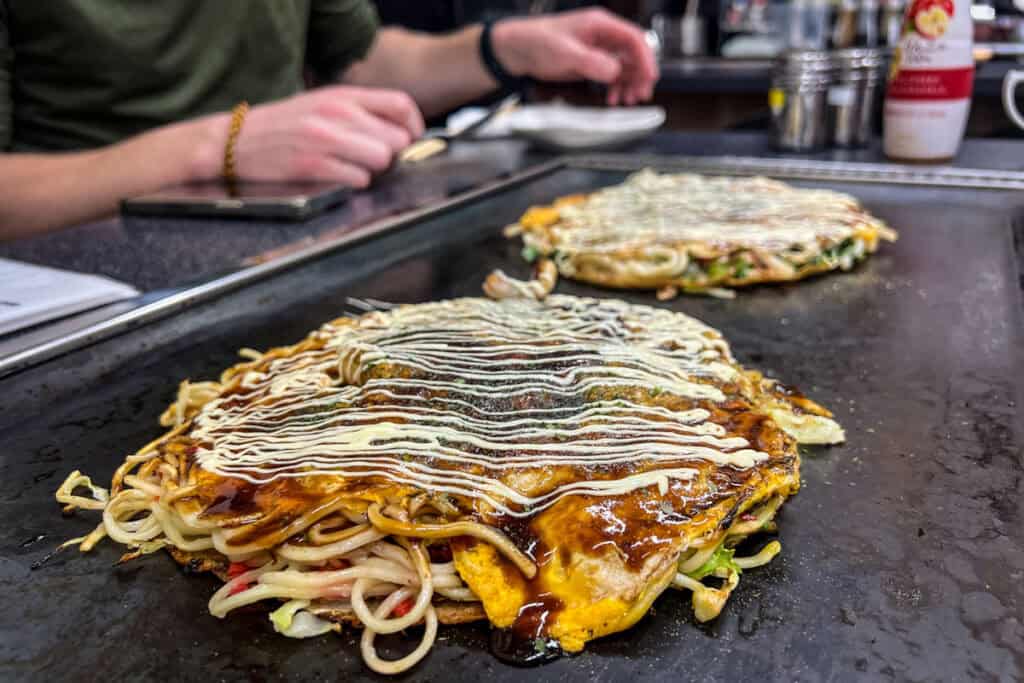
Here are some great dinner recommendations for your last night in Kyoto:
- Kamehameha: cozy okonomiyaki joint with great seafood and veg options (reservation recommended)
- Sushiro: casual and well-priced conveyor belt sushi (no reservation needed)
- Chao Chao Sanjo Kiyamachi: popular gyoza shop where you can sample many flavors (often has a queue)
- Gyukatsu Kyoto Katsugyu: highly-rated restaurant for grill-your-own beef cutlets
- Anzukko: small 2nd floor izakaya serving unique gyoza (reservations recommended)
Speakeasy or other night time exploring
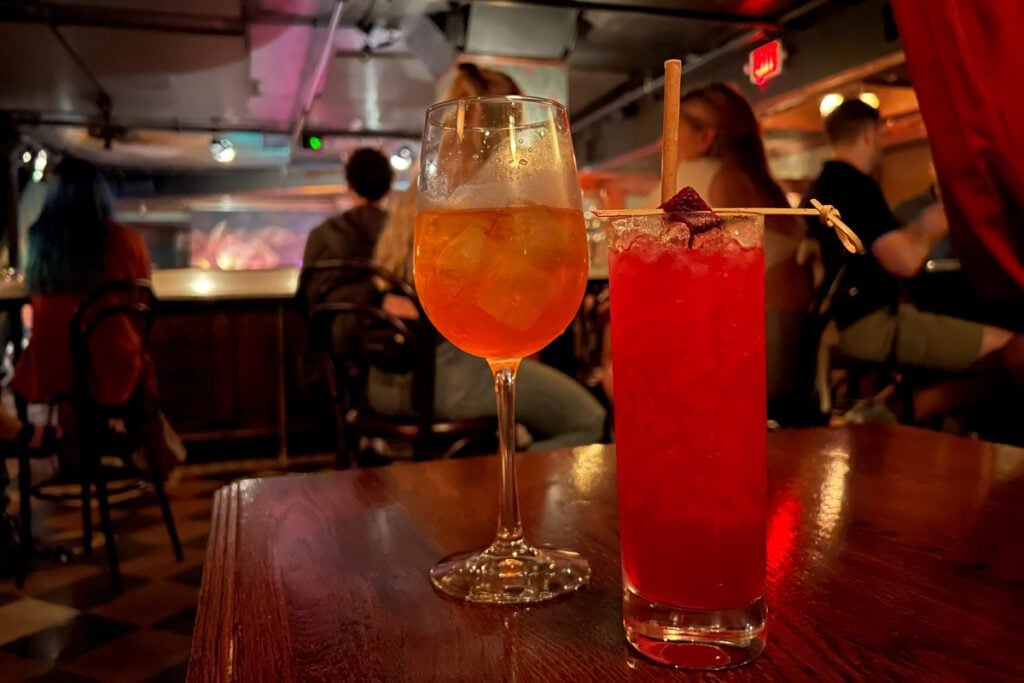
I don’t know what it is about a speakeasy, but we’re mildly obsessed. We’ve been to them all over the world, and Kyoto has some great ones.
- Bee’s Knees: This cozy cocktail bar has landed a spot on Asia’s 50 Best Bars list several times, meaning it’s no secret, but still very much worth a visit. Try their inventive Japanese twists on classic cocktails.
- opens at 6 p.m., closed Sundays
- Scotch & Branch: To get here, you must step through a phone booth – adding to the speakeasy charm! Once you’re inside, you’ll find a dimly-lit bar that specializes in whiskey.
- opens at 6 p.m. (3 p.m. on weekends)
- L’Escamoteur: Known for over-the-top presentation and expertly-crafted drinks, this is easily one of Kyoto’s best bars.
- opens at 8 p.m., closed Mondays
If speakeasies aren’t your thing or you’re traveling in Japan with kids, here are some alternative ways to spend a night in Kyoto:
- Grab an ice cream
- (THISIS)SHIZEN: beautiful (but pricey) Instagram-worthy ice cream cones in a plant-filled space (closes at 7 p.m.)
- Ice at 21:00: cute ice cream parfaits
- Walk along the edge of the Kamo River and wander the atmospheric Pontocho Alley
- See temples illuminated at night
- Book a karaoke box (aka a private karaoke room you can rent by the hour)
Kyoto itinerary map
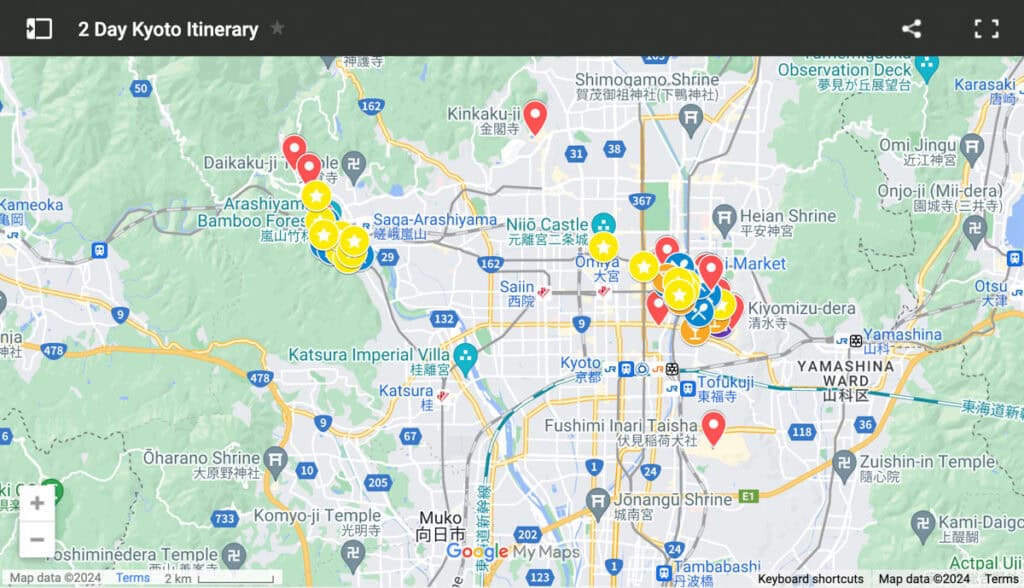
Click on the map and enter your email to gain access to the interactive Google Maps version of our 2-day Kyoto itinerary.
Have more than 2 days in Kyoto?
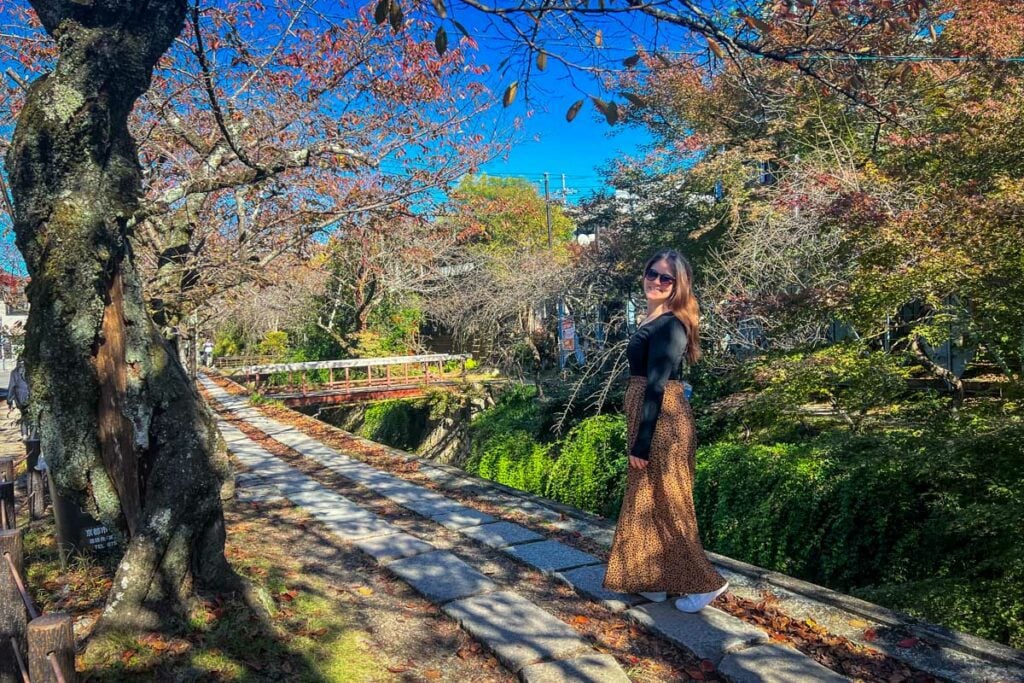
We love to hear it! There’s so much to see and do in Kyoto that you can never have too much time.
Here are some suggestions for things to do if you have more than 2 days in Kyoto:
- Any of the optional activities you didn’t do on Day 2 of this itinerary
- Walk the Philosopher’s Path from Ginkaku-ji (Silver Pavilion) to the Nanzenji neighborhood
- Take a Japanese cooking class
- Sample sake on a tour in the Fushimi Sake District
- Learn the ancient art of Japanese calligraphy
- Photograph Japan’s tallest wooden pagoda at Toji Temple
- Find Zen at a Japanese garden
Keep reading more exciting things to do in Kyoto – we have a ton of ideas!
Psst! Are you trying to choose whether to visit Osaka or Kyoto? Both are worth it if you have the time. But if you can only pick one, our Kyoto vs. Osaka guide can help you decide!
Best time to visit Kyoto, Japan
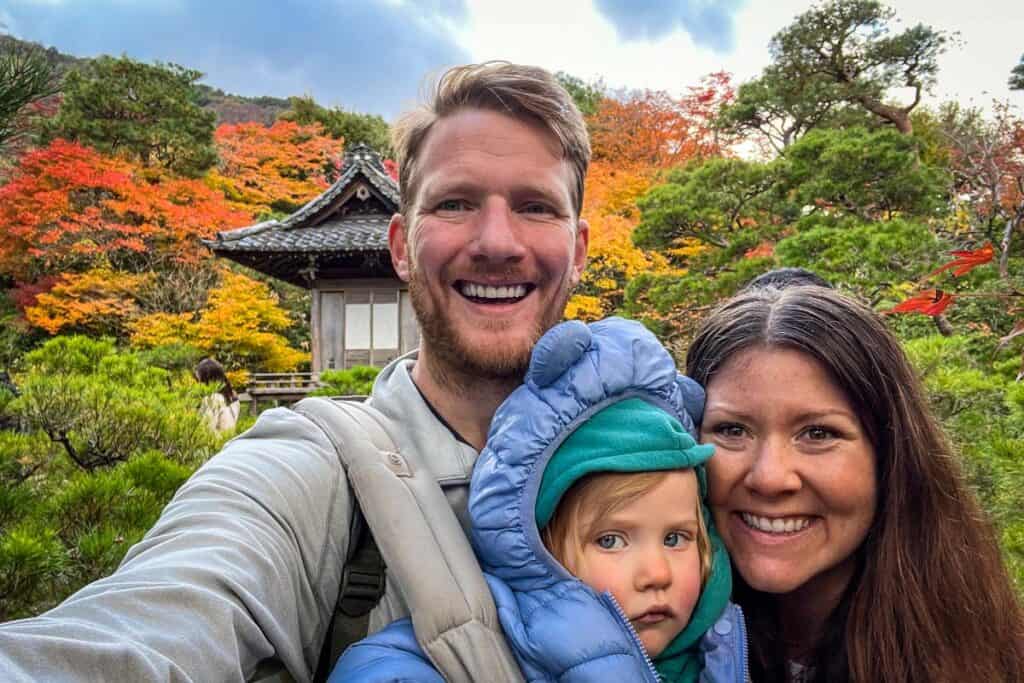
We’ve visited Kyoto in February and November, and we’ve also experienced Japan in August.
Overall, we think fall is the best time to visit Kyoto. The shoulder seasons offer better weather and more comfortable temperatures, and seeing the fall foliage in Japan was one of our favorite trips!
The only caveat is that fall can get pretty busy in Kyoto due to the popularity of momijigari, or “red leaf hunting”.
That said, the alternative season for great weather—spring—is even more crowded, as tourists flood the city to see the legendary cherry blossoms.
We’d personally take the momiji crowd over the sakura crowd.
For more details on seasonal weather patterns and tourist activity, check out our complete guide to the best time to visit Japan.
How to get around Kyoto
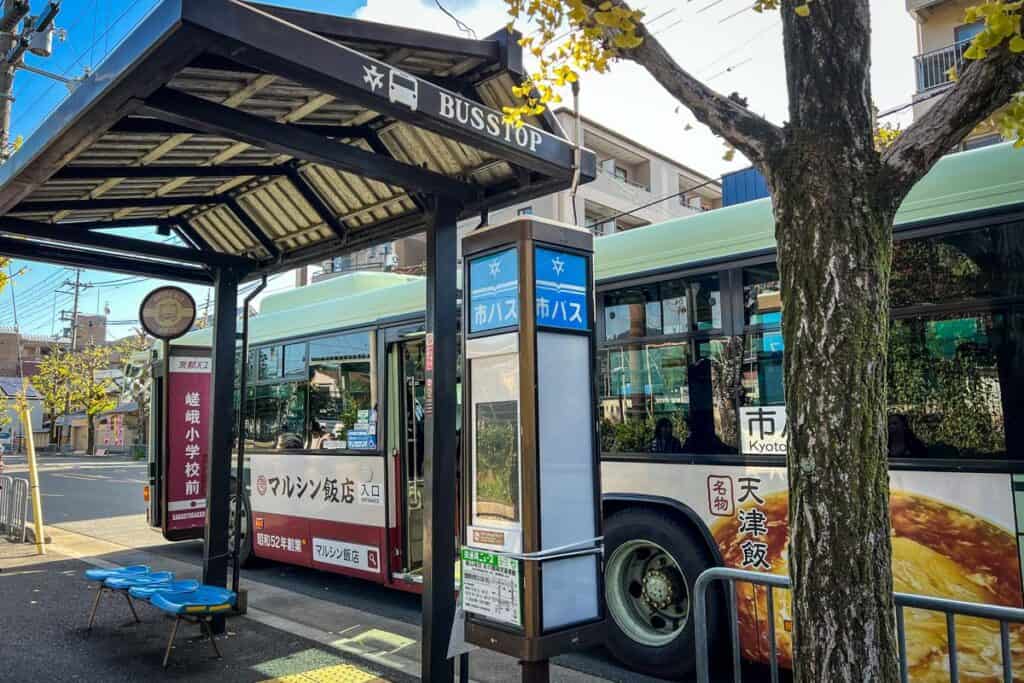
Kyoto has an extensive public transportation system, making it easy to get around. There are two subway lines: the Karasuma Line runs north to south and the Tozai Line runs west to east.
You can use an IC Card, like an ICOCA card, to get on and off most public transportation. You can purchase and recharge these cards near the train station and some convenience stores.
There is a network of bus lines throughout the city as well. If you are planning on exclusively using buses, you can purchase a 1-day pass and ride as many as you want for 24 hours. You might want to ask your hotel front desk which pass or card would be best for your time, location, and all the things you want to do in Kyoto.
Where to stay in Kyoto
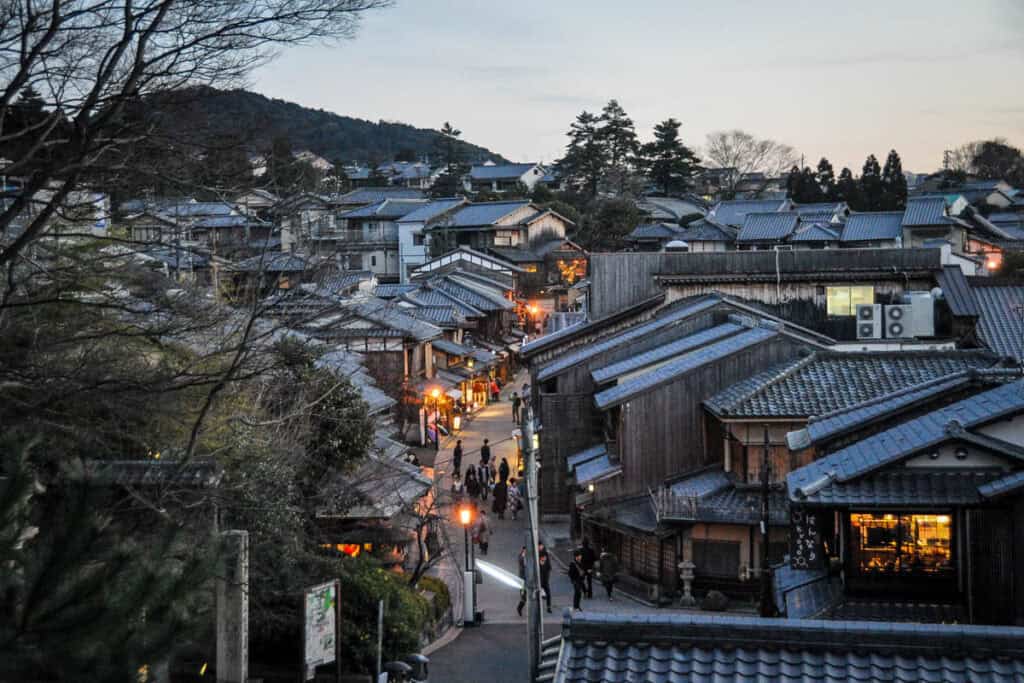
There are many incredible places to stay in Kyoto for travelers of all budgets. Below are our top picks for hotels, hostels, and Airbnbs.
We’ve selected some that are higher-end as well as several that are for travelers on a budget.
Our advice: If you are visiting Kyoto for the first time, we recommend you stay in the Gion and Southern Higashiyama districts.
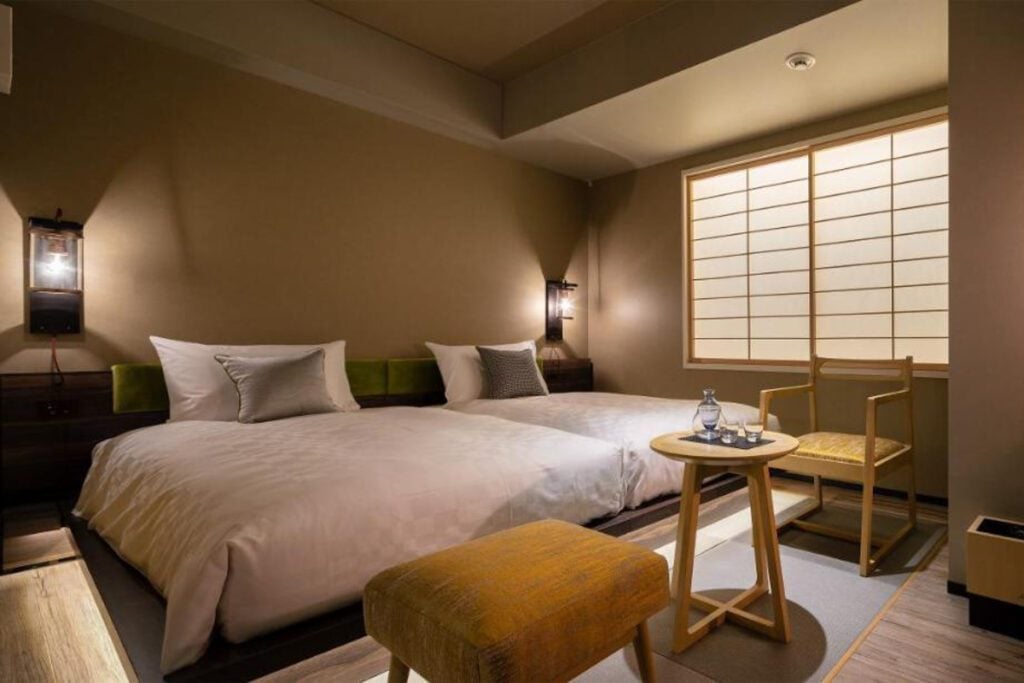
Best Budget Hotel: Hotel Resol Kyoto Kawaramachi Sanjo
This 3-star hotel is situated in the center of Kyoto and conveniently located next to the train station. Steps away are many popular shopping and dining areas, as well as popular Kyoto attractions.
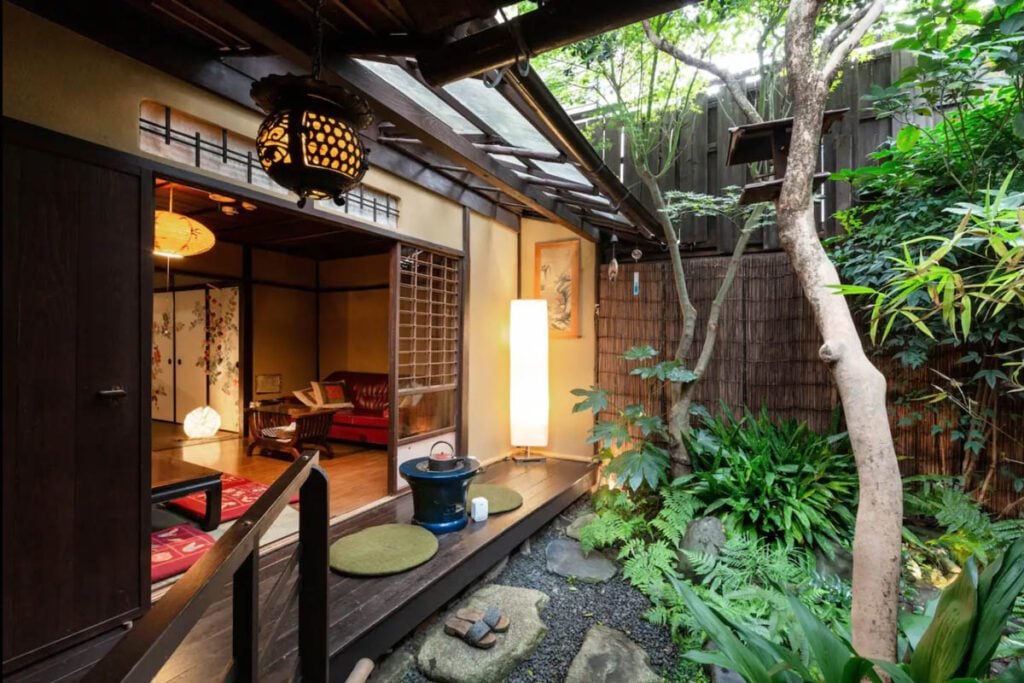
Budget Airbnb: 100 Year old Machiya Guest House
This charming guest house transports you back in time with its tatami interior and traditional Japanese garden onsite. Enjoy peace and stillness while still being close to many shops, stalls, and sites in Kyoto.
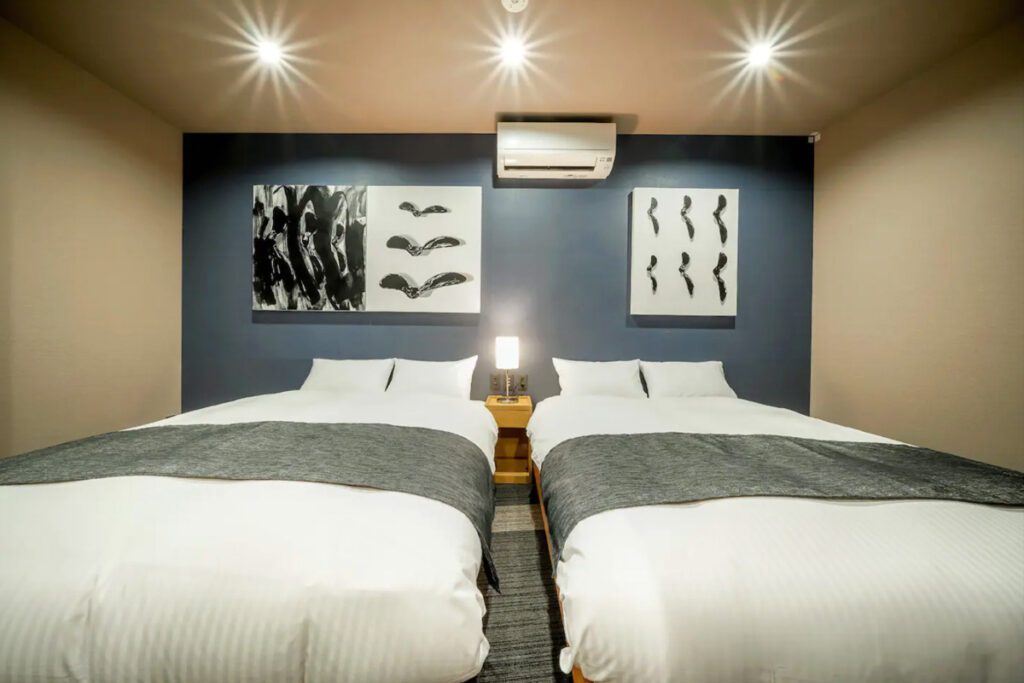
Luxury Airbnb: MaikoTown
Tradition meets modernity at this stay in the heart of the city. You can uncover many parts of the city others miss as it’s located down a quiet street lined with teahouses, but still close to many shops and restaurants.
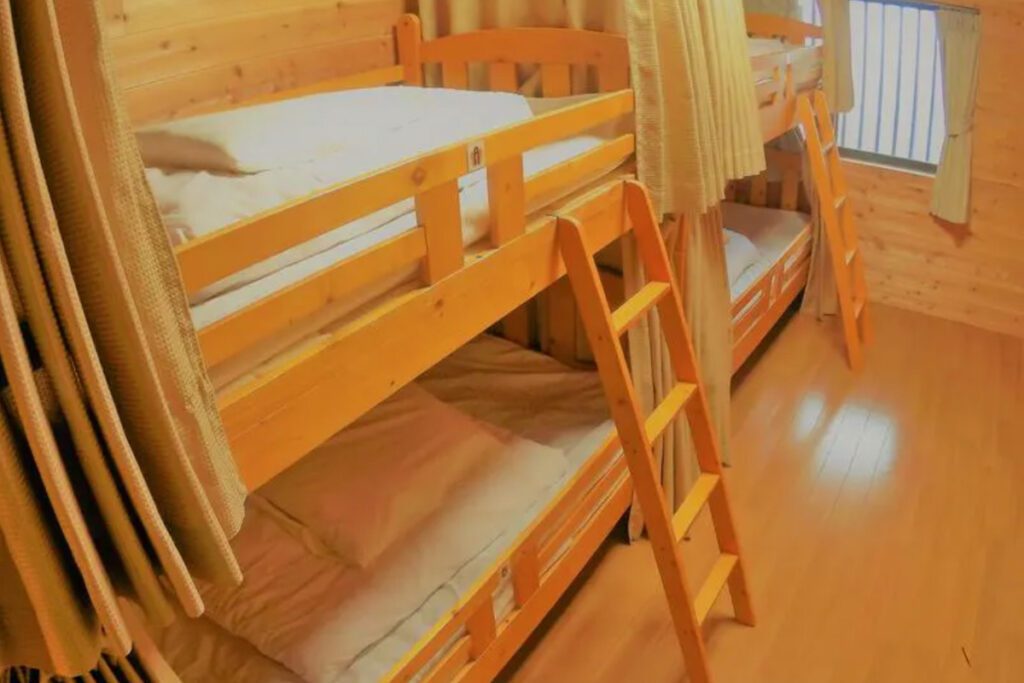
Best Hostel: Guest House Ga-Jyun
Stay in one of the most famous areas of Kyoto that’s close to temples, shrines, and the subway station. The ancient traditional Japanese house is cozy, convenient, and the ideal budget stay while in the imperial city.
Budget for 2 days in Kyoto
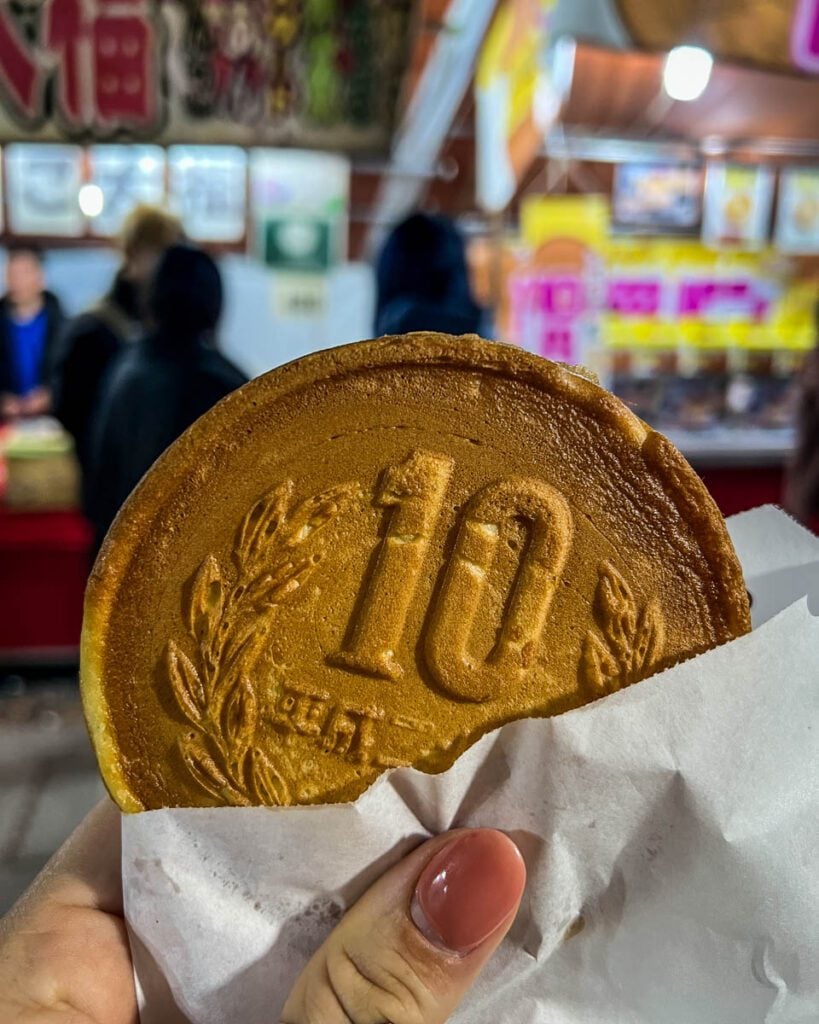
The average daily cost of expenses in Kyoto is about $250 USD per person.* This would make your budget around $500 USD per person for 2 days in Kyoto.
*Based on double occupancy accommodation, not including flights or trains to/from Kyoto.
Of course, as with all budgets, there are lots of variables to consider. There are ways to save money, and ways to spend a lot more. Below, we’ll break down the average costs of some popular activities and dining in Kyoto so you can get a good idea for your own budgeting.
Accommodation*
Cost for 2 nights based on double-occupancy rooms:
- Twin room in 3-star hotel in city center: $974 USD
- Entire condo Airbnb on quiet street: $534 USD
- 2 beds in 6-bed mixed dorm hostel: $113 USD
*Note the price of accommodation will vary pretty substantially by season in Japan. Prices will be much higher during peak tourism season and drop during low season.
Meals
Per person average meal costs
- Hotel breakfast: $20 USD
- Street food snack: ¥300 – 500
- Ramen or causal order-at-the-counter meal: ¥600 – 1,200
- Sit-down dinner: ¥1,200 – 1,500
- Cocktail at a speakeasy: ¥2,500
Entertainment
Cost for adult single entry ticket or tour
- Fushimi Inari Shrine hike: free!
- Entrance to Nishiki Market: free!
- Entrance to Kiyomizu-dera Temple: ¥400
- Guided walking tour of Gion: $34 USD
- Yasaka Shrine illuminations: free!
- Entrance to Otagi Nenbutsuji Temple: ¥400
- Entrance to Adashino Nenbutsuji Temple & bamboo grove: ¥500
- Entrance to Kinkaku-ji Temple: ¥500
- Tea ceremony: $22 – 46
- River cruise in Arashiyama: ¥1,500 – 6,000
- Iwatayama Monkey Park entry: ¥600
- Kimono forest art exhibit: free!
- Entrance to Jojakkoji Temple: ¥500
- Visit to Tenryū-ji Temple: ¥500 – 1,300
- Foot bath: ¥250 (includes towel you can keep)
Transportation
- Cost of an ICOCA metro card (refundable): ¥1,000
- Single bus ticket: ¥230
- Day pass for subway & bus: ¥1,100
- Kyoto to Fushimi Inari: covered by JR Pass
- Kyoto to Arashiyama: covered by Kansai-Hiroshima JR Pass
Unsure whether to get the Japan Rail Pass for your trip? Our JR Pass guide is full of info—as well as our totally honest opinions—that can help make this decision easier for you.
What to pack for visiting Kyoto
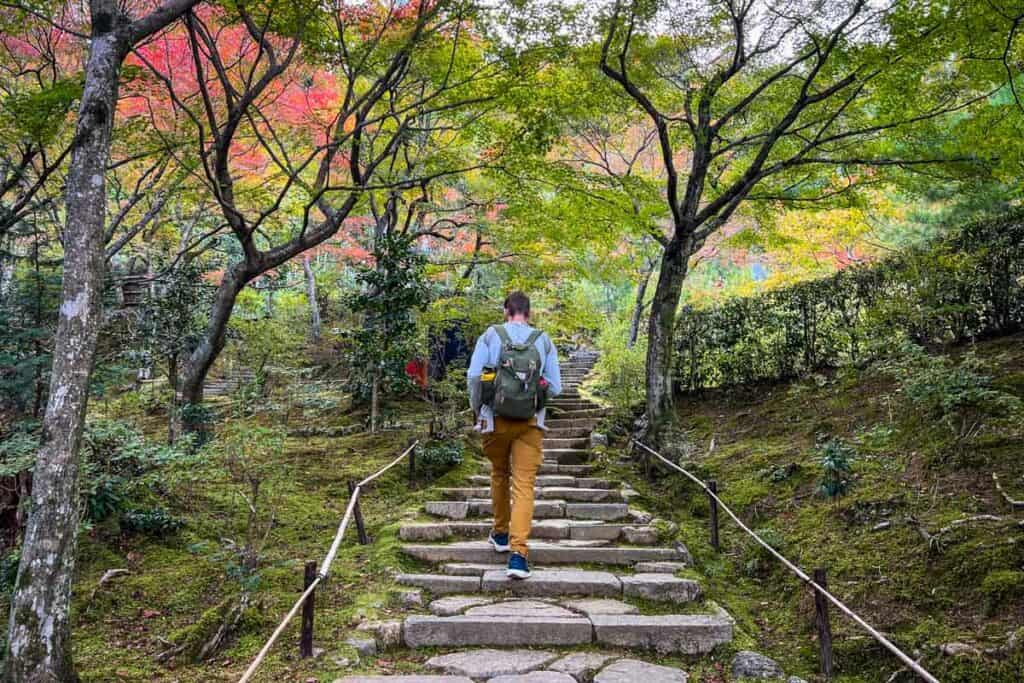
We know it can be overwhelming packing for a trip to a new destination. That’s why we spent hours creating these super helpful guides full of packing hacks and tips for traveling in Japan that you won’t find anywhere else:
- Our Japan packing guide lists all the essentials (many of which you might not think about), as well as what you should NOT pack for a trip to Japan.
- This article on what to wear in Japan will help you create a perfect capsule wardrobe for every season and let you in on some cultural taboos so you can be sure to dress appropriately.
- With this FREE Japan packing list PDF download, we’ll send checklists straight to your inbox for everything from clothing and toiletries (for both women and men!) to what shoes to pack and extra stuff you may want to have on-hand just in case. Click the image below to get your free copy!

Plan your trip to Japan
After 3 trips (and counting!), we’ve fallen head over heels for Japan—and we’ve created TONS of resources to help you plan your dream trip. Start with our Ultimate Japan Travel Guide and be sure to check out these helpful articles:
- First time? Our Japan Trip Planner walks you through everything you need to know.
- Use our Japan Rail Pass guide to determine if getting a train pass is optimal for your trip.
- Here’s our curated list of the best things to do in Japan—from iconic sights to once-in-a-lifetime experiences.
- Not sure where to go? Our Japan itinerary ideas will help you map it all out.
- Foodies, rejoice! This guide to what to eat in Japan will have you drooling before you land.
- This guide to what to wear in Japan (and what not to wear) will help you blend in.
- Use our ultimate Japan Packing List to make sure you don’t forget anything.
- Before you go, brush up on these essential Japan travel tips (including major do’s and don’ts!).
- Avoid awkward moments by brushing up on Japanese etiquette.
Still have questions? Drop us a comment—we LOVE helping travelers plan unforgettable trips to Japan!
Want to save time and energy on planning?
We’ve spent hundreds of hours (no joke!) researching for our 3 different trips to Japan, and we’ve been able to explore a lot of what this country has to offer!
We’ve compiled our experience to create the perfect trip for adventurous travelers that want to see iconic sights and hidden gems in the beautiful city of Kyoto, Japan.
This done-for-you itinerary is everything you need with 4 fully planned interchangeable days!
Just click the banner to get your Kyoto itinerary today!
Don’t miss your chance to grab our Kyoto map!
Get our custom Kyoto map sent straight to your phone! We loaded this map with all our favorite restaurants, sights, hidden gems, and more, so you can make the most of your time in Kyoto.
Just enter your email and we’ll immediately send you access instructions!
Save this itinerary on Pinterest for later!
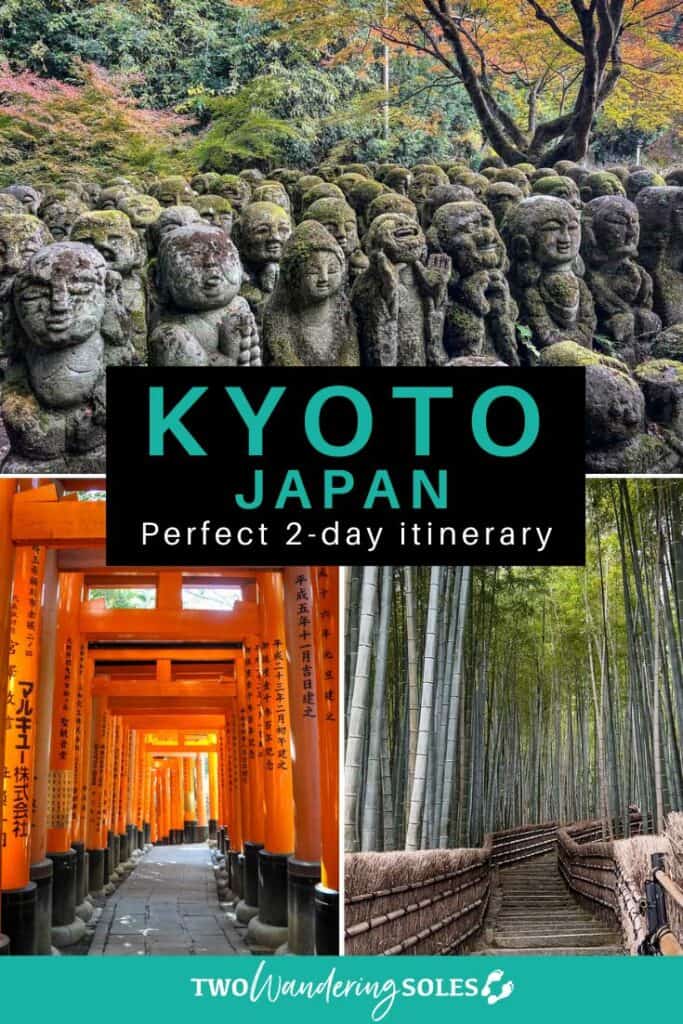
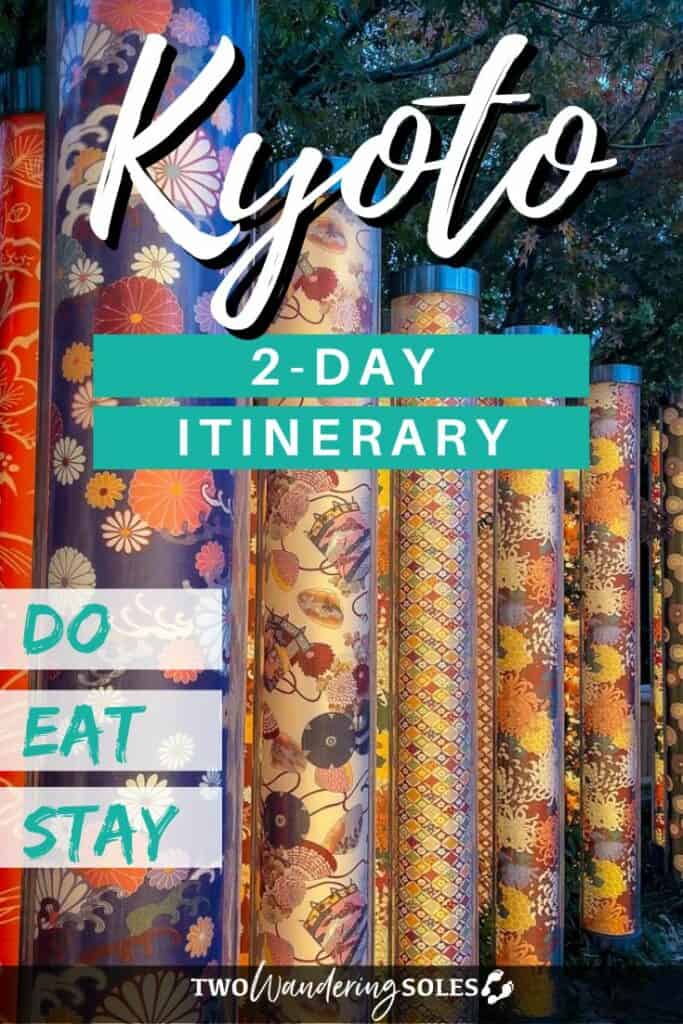
We want to hear from you!
Are you planning a trip to Kyoto and still have questions? Let us know in the comments below and we will do our best to get back to you!

